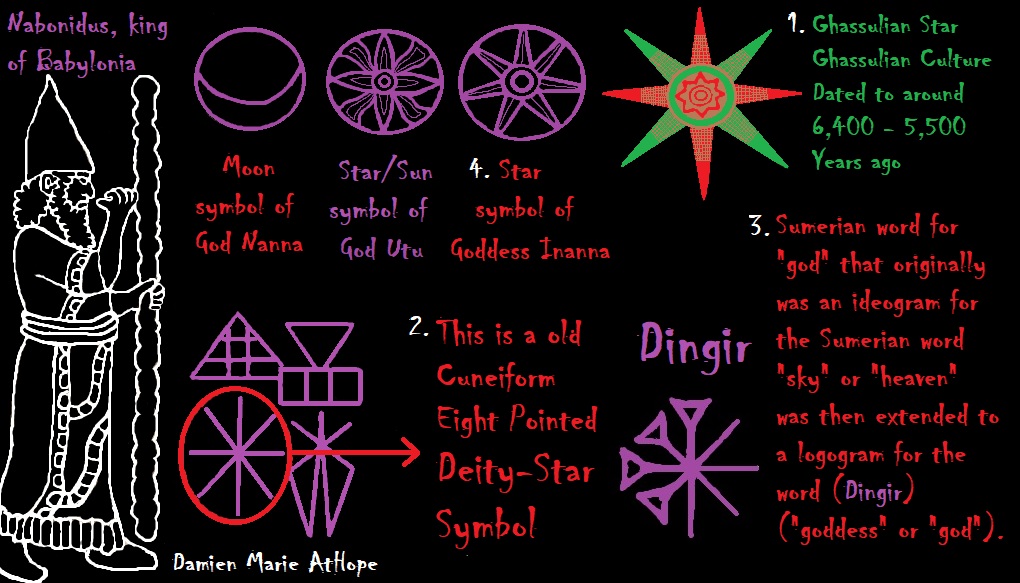
“The presence of dolmens are found in a few areas of Israel, with most dolmens known to the public found in the Golan Heights. Gamla is part of the Golan
There is a gigantic dolmen, with a 50-ton capstone over 4,000 years old with unique artistic carvings in its ceiling has been found in the Golan Heights. What makes this dolmen so unique is its huge dimensions, the structure surrounding it, and most importantly the artistic decorations engraved in its ceiling. ref, ref
“The Galilee dolmens date from roughly the same time as other mysterious, monumental structures discovered nearby in the Golan, most notably the extraordinary circular megalithic monument called Rujm el-Hiri, in the middle of a large plateau also covered with hundreds of dolmen shown above.” ref
“Gilgal Rephaim (Hebrew for “Circle of the Giants”) is a large megalithic monument that is just three miles east of the site of Gamla in the Golan. This area is known as the land of Bashan, where King Og lived and is located east of the Jordan River, and the Sea of Galilee in what would be the land of the tribe Mannaseh. King Og of Bashan, who according to Deuteronomy 3:11, “was the last of the Rephaim (giants), whose bed was decorated with iron and was more than nine cubits long (13 1/2 feet) and four cubits wide (six feet).” The structure has been dated by archaeologists to the Early Bronze Age (3000 – 2700 BCE), thus would have existed prior to the flood of Noah.” ref
“There is over 42,000 tons of boulders, partly worked, and stacked up to 2 meters (nearly 7 feet) high. The outermost circle is 520 feet in diameter. In order to see the entire structure, an aerial view is required. It is possible that the ancient inhabitants of this area practiced excarnation, that is the burial practice of removing the flesh from the bones of the deceased, perhaps leaving the body exposed for scavengers such as vultures. It is interesting that just three miles from this location is the Gamla Nature Reserve, at the site of ancient Gamla, which hosts one of the world’s largest known populations of Griffon vultures, and other birds of prey. Certainly, the later inhabitants of Gamla were very familiar with this site as it is a mere 3 mile walk up the Daliyot Stream. An interesting fact about Gamla is that, although thousands were have said to have died there during the Jewish Revolt in what is called “The Masada of the North”, unlike at Masada, no bodies have ever been found.” ref
Shamanistic pagan stone arrangement are seen in many areas ranging from piles of arranged rocks, Menhirs “monolith standing stone” found alone or as part of a group, to Dolmens. In Finland, a Napakivi (pole/navel stone) or tonttukivi (elf stone) is a standing stone connecting to fertility, protection or death, such as being placed the middle of a field, central spot or the heart of an pile of stones compiled burial mound and Juminkeko pole stones are located in the Western and Southwestern Finland and southeastern Norway is the main area of dolmens both of which may also have some cultural connection with sami seids as well as central European and Great Britian megaliths. ref, ref, ref
The Haga dolmen (Swedish: Hagadosen) is a thin slab “stone box” like dolmen, which dates to around 5,400 years ago containing several artifacts such as an amber necklace, slate jewelry, a flint knife, and a stone axe. Around 7,000 years ago Dolmens begin to be situated in Brittany France and were found in Britain, Ireland and southern Scandinavia about 4,000 Similarly, Sami seids (Finnish: Seita) maybe dolmen and other standing stones or stone arrangements which may also be associated with artifacts generally found at places north-European people believed to be sacred such as the mountains, tundra, lakes, or other natural formation. ref, ref, ref
Around 5, 000 years ago in the North-Western Caucasus, there are found dolmens (few tombs have breasts, done in relief), also seem to generally involve thin slab “stone box” like dolmens situated along the coast of the Black Sea. and southern Caucasus mountain range extends eastwards to the Caspian Sea in northwestern Iran, and into northeastern Turkey. Thousands of dolmens are scattered across the Middle East, from Turkey to Yemen. There is evidence a “dolmen phenomenon” of above-ground stone burial structures two sites in Hatay and five sites in south-eastern Turkey. Dolmen-like structures occur through much of the Levant commonly dating to around 5,300-5,000 years ago and around 4,000 years old Dolmen table-like burial structures with the multi-burial of both adults and children along with a roof containing engraved shapes depicting symbols involving a simple line attached to the inside of an open semicircle on its ceiling found at the Golan Heights in Israel. This is interestingly similar but reversed shapes to the Zuschen (megalithic dolmen tomb) Germany, dated to around 5,000 years ago with engraved shapes depicting symbols involving a simple line attached to the outside of an open semicircle, interpreted as possibly stylised cattle. ref, ref, ref
Another monumental stone display in Israel called Rujm el-Hiri, involves a circular monument of stones in the middle of a large plateau covered with hundreds of surrounding dolmens and ancient beads have been found at dolmens in the Galilee. Moreover, Dolmen like structures are also found in Switzerland, Italy, islands in the Mediterranean as well as in parts of Africa. Dolmens “monolith table top roof with standing stones,” which have different names in other languages, including Abkhaz (northwest of Georgia south of russia): Adamra, Adyghe Ispun, dysse; Dutch and Norwegian: hunebed; Galician and Portuguese: anta; German: Hunengrab/Hunenbett; Irish: dolmain; Korean: goindol/koindol or chisongmyo, Portugal: Granja, Spain: Galicia, and Swedish: dos. Dolmen like structures are also found in Switzerland, Italy, islands in the Mediterranean as well as in parts of Africa. Additionally, Dolmens may have served as places of ritual or worship and possibility a porthole to the spiritual world (some dolmans actually contain a circular porthole). The prehistory of Korean religious/cultural iconography includes paintings, rock carvings, and stones positioned for religious ceremonies that may connect to the Pit-Comb pottery culture. ref, ref, ref
Artwork found on dolmens in northern Israel might point out misplaced tradition
“Horned animals and different depictions have been found at three megalithic dolmen websites in northern Israel, eight years after the serendipitous discovery of engravings on the ceiling of a humongous dolmen within the space. The websites appear thus far to the so-called intermediate Bronze Age, a time about which little is understood. There are millions of dolmens within the southern Levant, primarily in Israel, Jordan, and Syria, however, they’re typically undecorated. Rock artwork from the interval is all however unknown within the northern reaches of Israel – although the Negev desert within the south is riddled with ancient rock art (that may be dated).” ref
“The report by Prof. Gonen Sharon of Tel-Hai School and Uri Berger of the Israel Antiquities Authority, published in Asian Archaeology, describes the three new dolmens, which the workforce defines as megalithic burial buildings product of unmodified massive rocks laid on each other, with no cementing between them. Really the primary adorned dolmen was found at Shamir in 2012, accidentally. Sharon was visiting the location together with his children one Shabbat and went inside the primary burial chamber there, and easily appeared up on the ceiling, he tells Haaretz. It appears no person had carried out that earlier than. Now wall decorations have additionally been discovered at a dolmen at Meshushim (aka Hexagonal River, which is definitely a stream that includes hexagonal volcanic basalt rock types). In Kiryat Shmona, a dolmen was discovered with a uniquely manipulated capstone ׂׂ(the large rock on high) that might – at a stretch – be described as much like a human face; and completely nonfunctional “cup-marks” have been engraved into the ceiling of dolmens at Umm el-Kalha and Shamir.” ref
A misplaced tradition?
“Relationship the dolmens is tough, however, Sharon and Berger say the overall consensus is that they’re from about 2450 to 2000 B.C.E. – an interval dubbed “the darkish age of the Bronze Age” (aka the intermediate Bronze Age). And so they consider the big stone buildings have a narrative to inform. Settlement and village life in Israel could have begun so long as 15,000 years in the past or extra. However the first proper cities in Israel started to come up within the Early Bronze Age, beginning about 5,000 years in the past – for instance, Jericho and Megiddo, Sharon explains. However then, on the finish of the Early Bronze Age, the large cities have been deserted. We don’t know why. “The cities of the early Bronze Age have been abandoned, and the mega-cities of the center Bronze Age weren’t established but,” Sharon says. “We see no vital settlement within the space. What do we discover? We discover dolmens.” ref
“Until just recently, the belief amongst students was that the dolmens, monumental however crude, have been made by rural nomads. However, Sharon doesn’t suppose there was a lawless “darkish age” in any respect. He thinks the mere existence of those incredible buildings, adorned or not, is indicative of group; of an enormous effort probably not by hundreds however not less than 100 individuals coming collectively and collaborating. The dolmen at Shamir incorporates a central burial chamber and 4 sub-chambers, all topped by a fantastical capstone that they estimate weighs 50 tons. The rocks comprising the perimeters must weigh 400 tons or so. “It’s a seeming hierarchical construction. By any standards that is monumental development, and it’s simply one in all greater than 400 in simply the Shamir space,” Sharon says. Given the necessity to plan, arrange and feed the builders, and want for architectural know-how, taken collectively the dolmens point out that some sort of subtle or highly effective geopolitical entity existed on the time, not mere teams of unrelated nomads, he sums up. And like the best of all empires, that of the nomadic Mongols led by the great Genghis Khan, it could effectively have left behind no archaeological proof – apart from these extraordinary dolmens dotting the land.” ref
Crescent-headed individuals
“The Shamir subject on the slopes rising from the Hula Valley incorporates greater than 400 basalt dolmens. The nice one with the 50-ton capstone was discovered to comprise 4 our bodies in a subchamber and, as observed by Sharon that Shabbat morning, it has 14 types engraved on the ceiling, all alongside the identical motif: arcs with a straight line down their center, that look quite like hen footprints or pitchforks. What their significance is perhaps is anyone’s guess. “Given the burial context, a doable interpretation of the Shamir engravings is that they’re schematic human types or symbolic representations of the soul of the deceased,” Sharon and Berger recommend.” ref
“One other barely much less exalted suggestion, based mostly on rock artwork within the Negev, is that they signify crescent pommel handles of daggers, that are believed, thus far, to across the similar interval. Or crescent-headed individuals, depictions of that are additionally discovered within the Negev.
Transferring onto Meshushim, the location of the hexagonal basalt, the adorned dolmen is positioned excessive up and could also be a lonely remnant of a as soon as huge subject of dolmens within the space, which have been destroyed. Its courting to the Early Bronze Age relies on a bronze knife discovered on the floor instantly subsequent to the dolmen’s northern wall. The knife’s composition of copper with arsenic is typical of the Early Bronze Age. This dolmen has rock artwork panels on the inside face of three of the boulders forming the partitions of the burial chamber, and in distinction to the hen toes/crescent heads, these – although crude and worn by time – are clearer of their topics, not less than seen with cutting-edge imaging know-how. One panel reveals six horned ungulates; variations within the shapes of their horns signify they could depict completely different species. Two of the animals appear to be dealing with each other: the archaeologists postulate that one is male and that we are able to see its penis, and the opposite is feminine. One has a striped physique paying homage to a kudu, although its horns are nothing like these of that African antelope.” ref
“The same stripey horned ungulate was additionally engraved on one other of the chamber partitions. And the primary recognized zoomorphic rock artwork present in northern Israel and in Levantine dolmens on the whole, although such drawings are widespread in rock artwork discovered all through the Negev desert, in Israel’s south. The third rock artwork panel at Meshushim reveals summary types: crosses enclosed by rectangles. As mentioned, the dolmens are characterized by monumental development utilizing unhewn rocks. The capstone at one dolmen within the subject of dolmens discovered at Kiryat Shmona in northern Israel is completely different. The dolmens on this a part of the nation are additionally a product of basalt however are smaller, all consisting of circles of stones surrounding a single chamber, which averaged 1 x 2 meters, with the diameter of the stone circle reaching as much as 10 meters (practically 33 toes). Their courting is unknown, because the chambers of the dolmens found thus far – and destroyed on account of fashionable development – have been empty, probably on account of looting or vandalism in antiquity. However they apparently date to the intermediate Bronze Age like the opposite dolmens, Sharon says.” ref
“There is a large Capstone with grooves, that some really feel appears like a face. This “face” is engraved onto a dolmen capstone, Kiryat Shmona. The capstone of the dolmen in query measures 2 × 2 meters and is 40 centimeters thick, and it was clearly labored. A number of deeply carved straight grooves are nonetheless seen and, the archaeologists observe, one might suppose they resemble a “humanlike face”: the 2 pairs of quick strains mark the eyes and an extended line represents the mouth of the determine. Nonetheless, just like the famed “human face” on Mars, it is all in regards to the eye of the beholder, and Sharon and Berger are usually not suggesting this capstone was carved to appear to be a face. There may very well be any variety of the reason why the capstone was carved – together with that it was carried out later, in an abortive try to repurpose the capstone for different development. “Reuse of dolmen capstones and different massive stones in subsequent development is a well-known phenomenon in southern Levant archaeology,” they observe of their paper.” ref
“All that may be mentioned is that the grooved capstone of Kiryat Shmona appears distinctive within the annals of Levantine dolmens. Talking of non-utile marks, the archaeologists describe a specimen within the dolmen subject of Umm el-Kalha, additionally apparently courting to the Intermediate Bronze Age. The dolmen in query additionally has one chamber, a rectangle on this case – four x 1 meters and round 80 centimeters in peak. 4 cup-like indentations, fairly massive at 10 to 12 centimeters in diameter, have been engraved into the basalt ceiling. Helpful, they might not have been. The Golan has loads of cup-like depressions carved into basalt rock, however, these are interpreted as mortars used to grind grain, extract oil or probably even to melt meat. There has additionally been a suggestion that large mortars carved into the bedrock have been used as drums to summon the tribe. It has been postulated that cup-like depressions reduce into dolmen surfaces have been ritual in goal and will have been used as receptacles for blood. That revolting notion is contradicted by this discovery, as being the wrong way up, the cup depressions of Umm el-Kalha couldn’t maintain something. Sharon and Berger recommend they have been a creative flourish – an uncommon factor in these elements, it appears. In the end, the archaeologists discovered two distinctly creative panels: that carved capstone paying homage to an emoji that can’t definitively be described as artwork, and the non-utile cupmarks, that are widespread however in different cases are typically utile. Being on the ceiling of this dolmen, utile they weren’t. “However they should have had some that means,” Sharon says. “We recommend it was ornamental or symbolic.” ref
Monumental Carved Dolmen More Than 4,000 Years Old Found in Golan Rewrites History of Civilization
“The burial monument’s sheer size and dating from around the time of other Golan monumental artifacts suggest the evolution of culture was more complex than had been thought, Prof. Gonen Sharon. A gigantic dolmen over 4,000 years old with unique artistic carvings in its ceiling has been found in the Golan Heights.” ref
Art Discovered on Dolmens in Northern Israel Could Indicate Lost Culture
“Panels showing horned animals and non-utile cups carved into the ceiling of the monumental Bronze Age structures could attest to a powerful unknown civilization of nomads, archaeologists suggest. Horned animals and other depictions have been discovered at three megalithic dolmen sites in northern Israel, eight years after the serendipitous discovery of engravings on the ceiling of a humongous dolmen in the area. The sites seem to date to the so-called intermediate Bronze Age, a time about which little is known.” ref
Megaliths in Mecklenburg-Vorpommern
“Mecklenburg is a historical region in northern Germany comprising the western and larger part of the federal-state Mecklenburg-Vorpommern. There are up to 5,000 megalith tombs were erected as burial sites by people of the Neolithic Funnelbeaker (TRB) culture. More than 1,000 of them are preserved today and protected by law. Though varying in style and age, megalith structures are common in Western Europe, with those in Mecklenburg-Vorpommern belonging to the youngest and easternmost—further east, in the modern West Pomeranian Voivodeship of Poland, monuments erected by the TRB people did not include lithic structures, while they do in the south (Brandenburg), west (Lower Saxony and Schleswig-Holstein) and north (Denmark).” ref
“Though megaliths are distributed throughout the state, their structure differs between regions. Most megaliths are dolmens, often located within a circular or trapezoid frame of singular standing stones. Locally, the dolmens are known as Hünengräber (“giants’ tombs”) or Großsteingräber (“large stone tombs”), their framework is known as Hünenbett (“giants’ bed”) if trapezoid or Bannkreis (“spellbind circle”) if circular. The materials used for their construction are glacial erratics and red sandstones. 144 tombs have been excavated. The megaliths were used not only by the bearers of the TRB culture, but also by their successors, and have entered local folklore.” ref
“The megaliths in Mecklenburg-Vorpommern were erected as burial sites in the Neolithic, by the bearers of the Funnelbeaker (TRB) culture, between 3,500 and 3,200 BC. Initially, the TRB people buried their dead in pits, often covered with mounds of clay. Later, they erected dolmens for this purpose but also continued the use of flat graves. All megaliths were erected during a relatively short time period, spanning about 200 years or about seven generations, with the oldest ones dating to phase C of the Early Neolithic, while most were built in the beginning of the Middle Neolithic.” ref
“The dolmens were built from glacial erratics, with the gaps filled with red sandstone. Presumably, standing stones were transported to the site using rollers, slides, levers, and ropes, and the interior of the unfinished dolmens was filled with clay to form a ramp to enable the movement of the cover stones into their final position. After removing the clay from the interior, a barrow (tumulus) was then raised on top of the dolmen, which remained accessible through a passage made from smaller stones. In addition, single standing stones were sometimes placed around the dolmen, forming either a rectangular or trapezoidal shape (Hünenbett), or a stone circle (Bannkreis). Sometimes, large singular “guardian stones” (Wächterstein, Bautastein) were placed adjacent to these shapes. The interior of the dolmen was usually divided into small compartments by slabs of red sandstone, standing upright.” ref
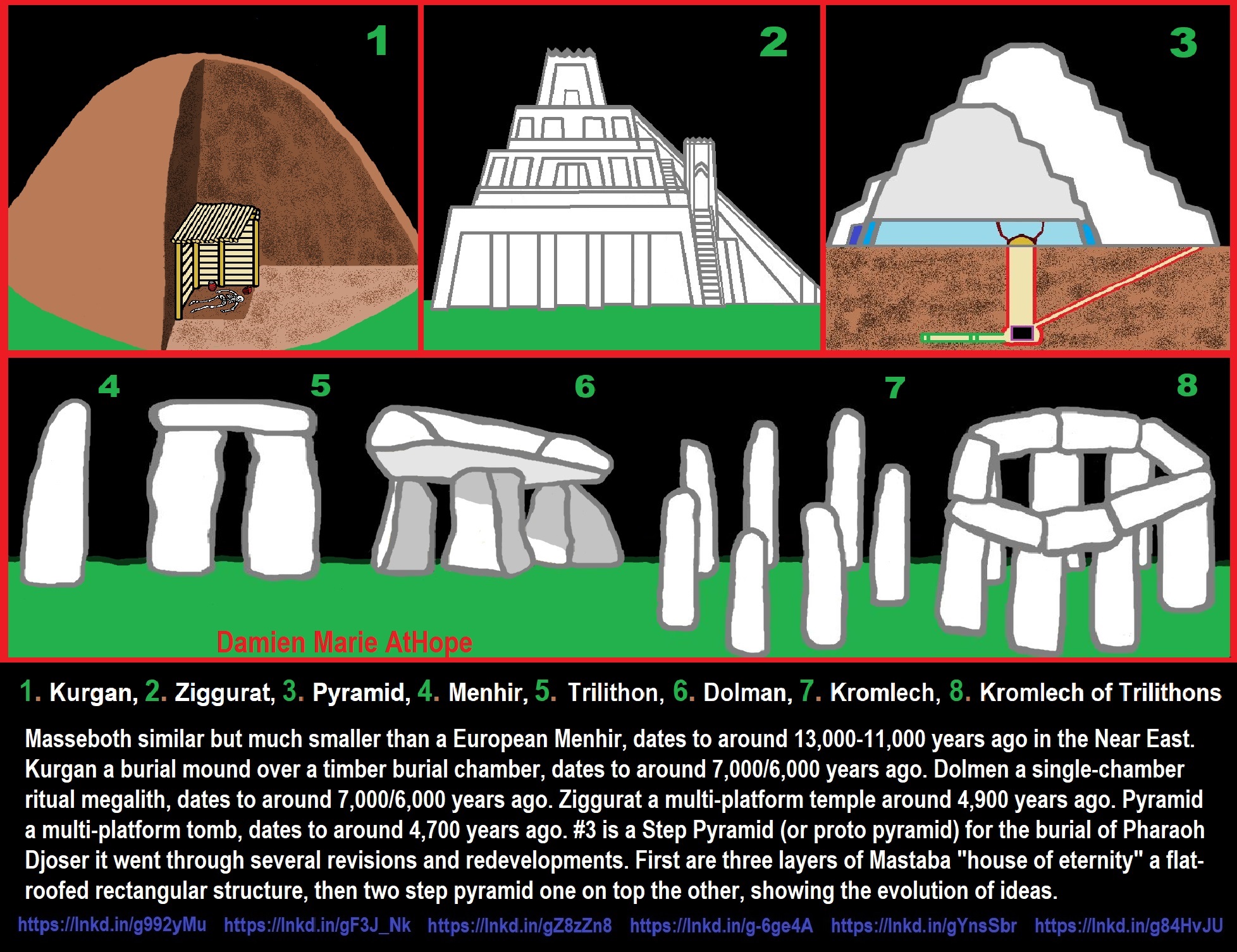
ref, ref, ref, ref, ref, ref, ref, ref, ref, ref, ref, ref
Masseboth similar but much smaller than a European Menhir, dates to around 13,000-11,000 years ago in the Near East. Kurgan a burial mound over a timber burial chamber, dates to around 7,000/6,000 years ago. Dolmen a single-chamber ritual megalith, dates to around 7,000/6,000 years ago. Ziggurat a multi-platform temple around 4,900 years ago. Pyramid a multi-platform tomb, dates to around 4,700 years ago. #3 is a Step Pyramid (or proto pyramid) for the burial of Pharaoh Djoser it went through several revisions and redevelopments. First are three layers of Mastaba “house of eternity” a flat-roofed rectangular structure, then two step pyramid one on top the other, showing the evolution of ideas.
“A dolmen is a megalithic structure typically formed from a large horizontal stone slab resting on two or more upright slabs. The oldest European examples are found in Brittany, northern France, and date to the 5th millennium BCE. Dolmens are also present in the Middle East, North Africa, Asia, and especially large numbers exist in Korea, with examples there dating to c. 1000 BCE. The structures functioned as burial chambers or as sites of ancient cult worship, for example to an earth or fertility goddess.” ref
“Brittany is well known for its stone monuments like dolmens, menhirs, and alignments. Exploring the megalithic culture of Brittany shows boulders towering over their landscape can seem majestic, but when they’ve clearly been moved to create a monument over thousands of years ago, it is breathtaking. Many people recognize the name Stonehenge, a circular megalithic monument in Wiltshire, England, but this does not compare to the plethora of manmade masterpieces that litter the northwest of France. In Brittany, there is a myriad of these Megalithic Monuments. Most of these sites date between 4800 BC and 3500 BC. Each one has been built over time using amazing feats of strength. Some of the most stunning monuments are in Carnac. The formations you will see maybe alignments, where these large stones have been placed a few feet apart in a line for usually aesthetic and astronomical purposes. Or you may come across dolmens, which appear as little huts, made of multiple tall boulders holding up a flat rock on top used as a roof. These may have been used as houses, animal coops, tombs, or simple meeting places over the years. Tumuli often litter the hills, as they mark gravesites and tombs. Cairns are stacks of rocks to signify trails or significant historical moments that took place. The final category, and often most surprising, is the menhirs. These large, tall stones stand-alone, often overlook vast valleys or civilizations, and often appear as a watchtower.” ref
Déhus Dolmen
“The Déhus dolmen is a Neolithic dolmen located in the parish of Clos du Valle on the island of Guernsey. The name Déhus probably comes from the old Norse Dys (or Dysse) meaning dolmen. It is a corridor dolmen delimited by about thirty orthostats. It is buried under a circular tumulus surrounded by a wall of facing consisting of an alternation of large blocks of standing stone and stones laid flat. The entrance opens to the northeast, towards the coast. It is enhanced by a trilith. Three stones were found in situ, the lintel was added and replaced by the archaeologist GE Lee in 1898. The corridor, oriented east/west, is 3 m long and 1 m wide. It is covered with four slabs of cover. It serves several side rooms, now not visible, and leads to a terminal room. The number and layout of these secondary chambers is uncertain. Lukis mentions only four rooms (numbered from A to D). The fifth bedroom could be the result of an incorrect restoration. The terminal chamber, “bottle-shaped” typical of some megalithic monuments of Normandy ) and the Channel Islands, is relatively spacious. It is about 6 meters long and 3.50 meters wide. A central pillar supports the ceiling consisting of several slabs, one of which is engraved with an anthropomorphic figure called “the guardian of the tomb.” The ceiling height is insufficient to stand up, you must lie on your back to contemplate. It is composed of a human face and hands arranged on the narrow edge of the stone, the fingers seeming to come out from beneath the stone. The soil contained many shells of limpets as well as cremated remains of bones. It is in the oldest layer of the soil, made of yellowish clay, that human skeletons, various bones, cut stones, bone tools, and fragments of pottery were discovered.” ref
“Side Room A measures 1.60m by 1.65m with a ceiling height of 1.45m. Lukis discovered human bones, ceramic shards (including a fragment of the base of a decorated terracotta cup), and a polished serpentine ax. Side Room B is a small room of 1.07m at the widest whose narrowness does not allow to sneak inside. The initial ceiling height was 1.27m. Most of the north wall was completed by dry masonry. Underground, at a depth of 0.15m, Lukis discovered two skulls belonging to two complete skeletons facing east and west with knees together in different directions. No archaeological material was discovered. Side Room C is the largest of the side rooms, discovered by Lukis in 1847. Of oval shape, its diameter is between 1.47m and 1.68m and the ceiling height is 1.42m. The excavation revealed a layer of pebbles mixed with many shells of limpets and three groups of human bones arranged on flat slabs. The group to the south was a child’s bones. Side Room D was searched by Lukis in 1847. According to Lukis, it had several periods of use. The soil consisted of two distinct levels of deposits: a first level composed of human bones resting on a bed of slabs and a second level, approximately 0.30 m below, composed of a second bed of slabs covered with bones. In the south-east corner and west of the room, Lukis discovered skeletons in a squatting position. On the north side, a bowl-shaped pottery rested on three triangular stones. This bowl is the only ceramic discovered in the room.” ref
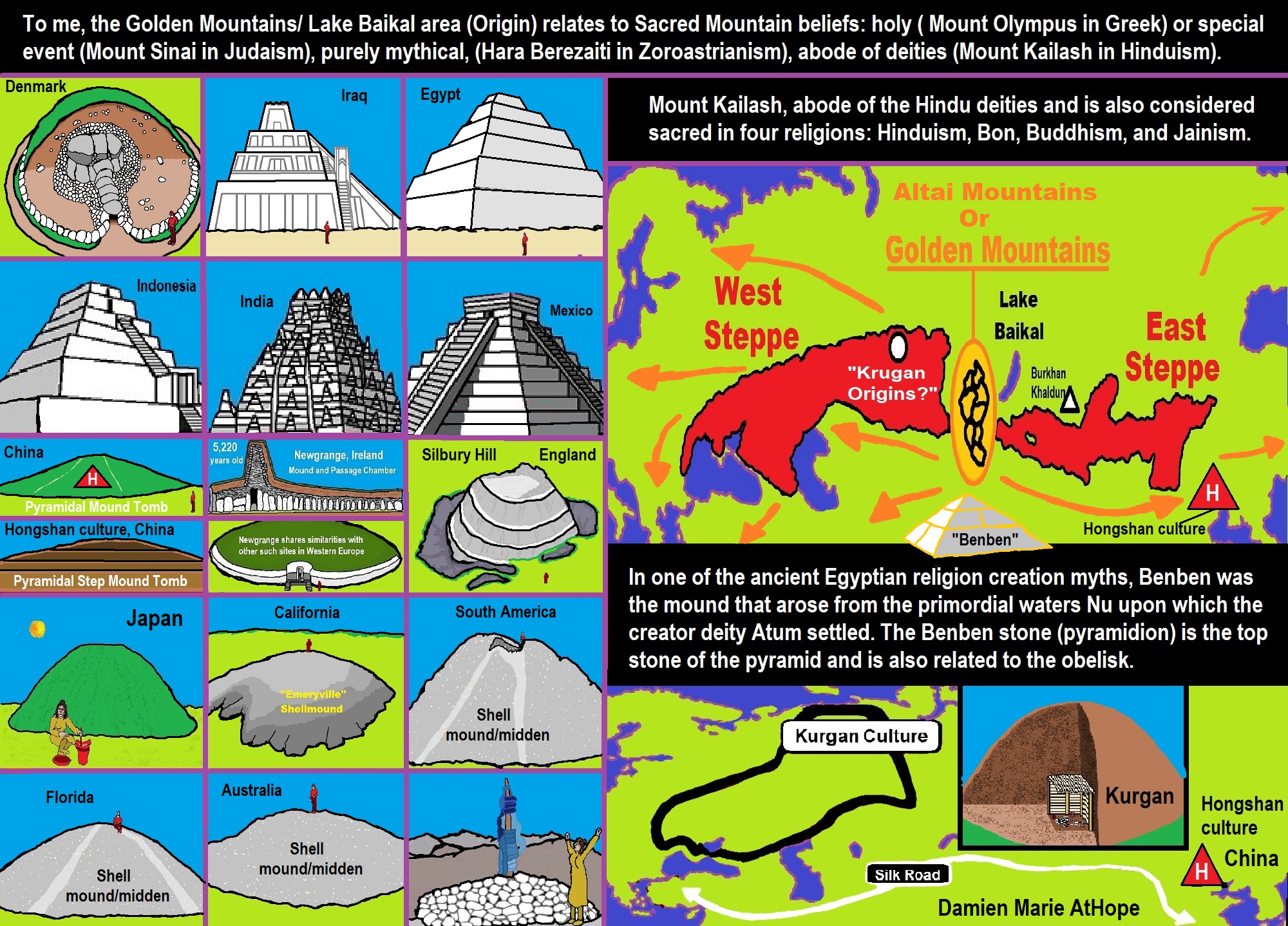
- Sacred Mounds, Mountains, Kurgans, and Pyramids may hold deep connections?
- Religious/Ritual Ideas, including goddesses and gods as well as ritual mounds or pyramids from Northeastern Asia at least 6,000 years old, seemingly filtering to Iran, Iraq, the Mediterranean, Europe, Egypt, and the Americas?
- The Center of the World “Axis Mundi” and/or “Sacred Mountains” Mythology Could Relate to the Altai Mountains, Heart of the Steppe
Connected “dolmen phenomenon” of above-ground stone burial structures?
Archaeologists analyze previously undiscovered Stonehenge carvings with help of Bentley Pointools
“While the mysteries of Stonehenge, constructed in England between 3,000 and 2,000 BC, may never be truly revealed or understood, a recent examination of the historic monument using cutting-edge visualization tools has unearthed some fascinating carvings that date to the Bronze Age. It is not yet known what questions about Stonehenge these carvings will answer, but the project did demonstrate the potential for using laser-scanning and visualization technology on the world’s antiquities. During the project, each stone was recorded with point spacing of 0.5 millimeters by the Greenhatch Group survey company. The resulting resource, comprising more than 850 GB of survey data, would lead to new discoveries about the monument. In April 2012, the enormous task of examining the data was awarded to ArcHeritage, part of the York Archaeological Trust, whose Geomatics and Visualisation team examined the laser scan survey. One challenge was to visualize a large amount of information and identify and isolate very subtle features. A preliminary examination of meshed models showed promising signs of useful information in the data set. For example, individual tool marks more than 5,000 years old could be seen and identified, but there were also tantalizing hints that the data contained prehistoric artwork carved onto the surfaces of the stones. When ArcHeritage researchers used Bentley Pointools to analyze 850 GB of laser-scanning data, they discovered 72 previously unknown prehistoric carvings. Examining the meshes alone was not sufficient to draw out these ancient carvings from the data; a different method had to be employed. The team decided to visualize the original point-cloud data and created a workflow using Bentley Pointools, which enabled large datasets to be loaded, which facilitated the examination of the full 0.5-millimeter-resolution data. In addition, the shading functions in Bentley Pointools proved instrumental in visualizing subtle features.” ref
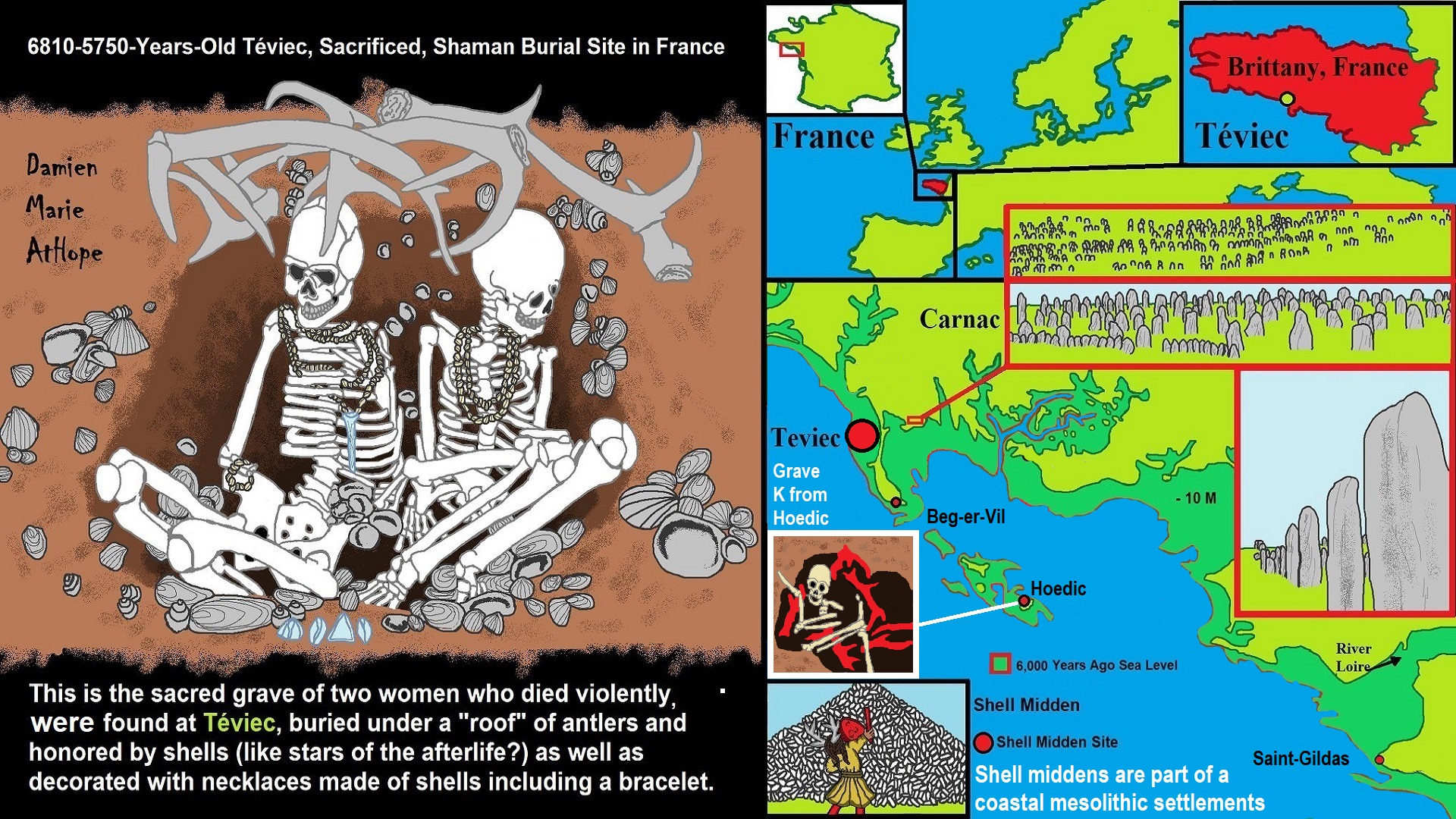
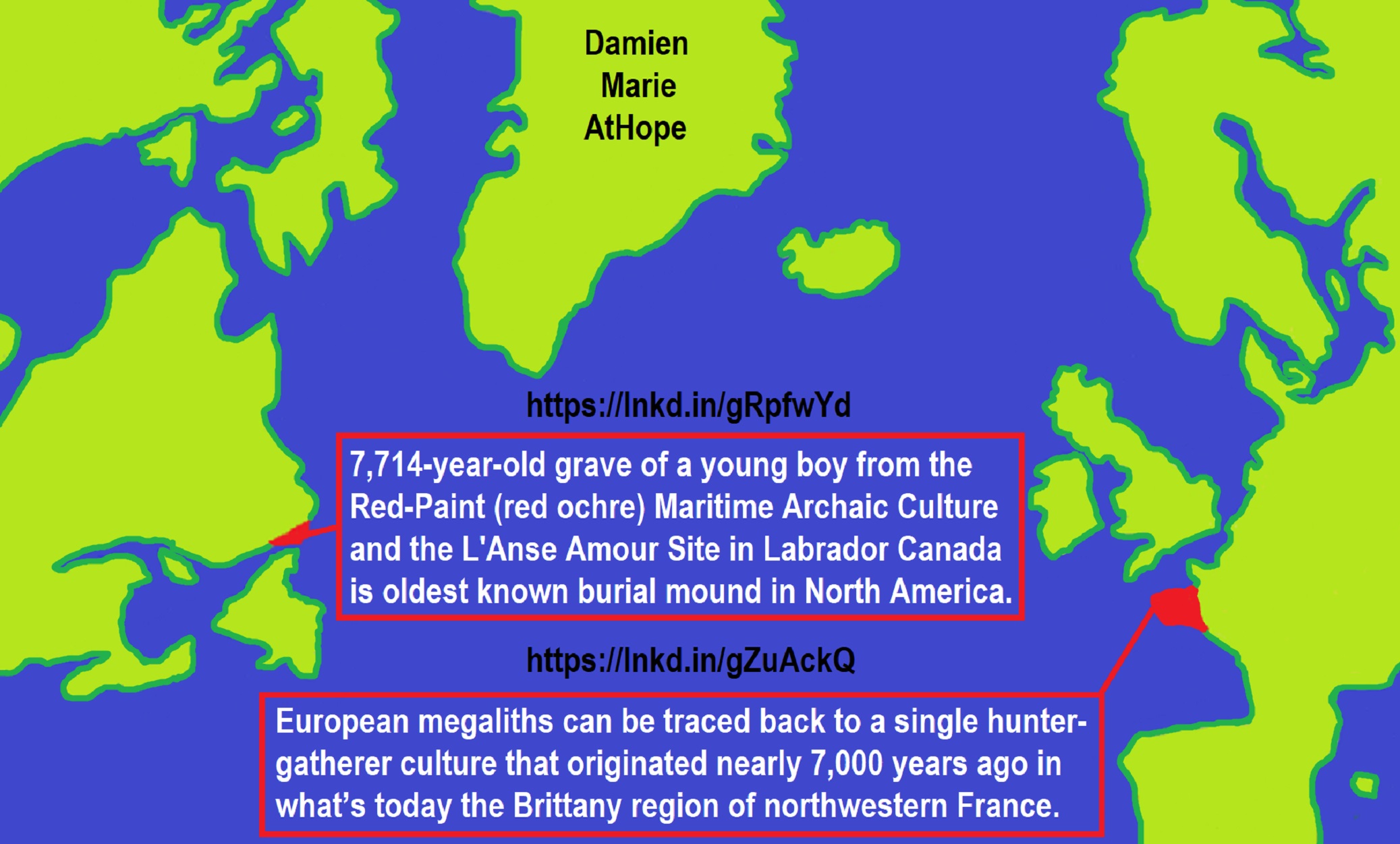
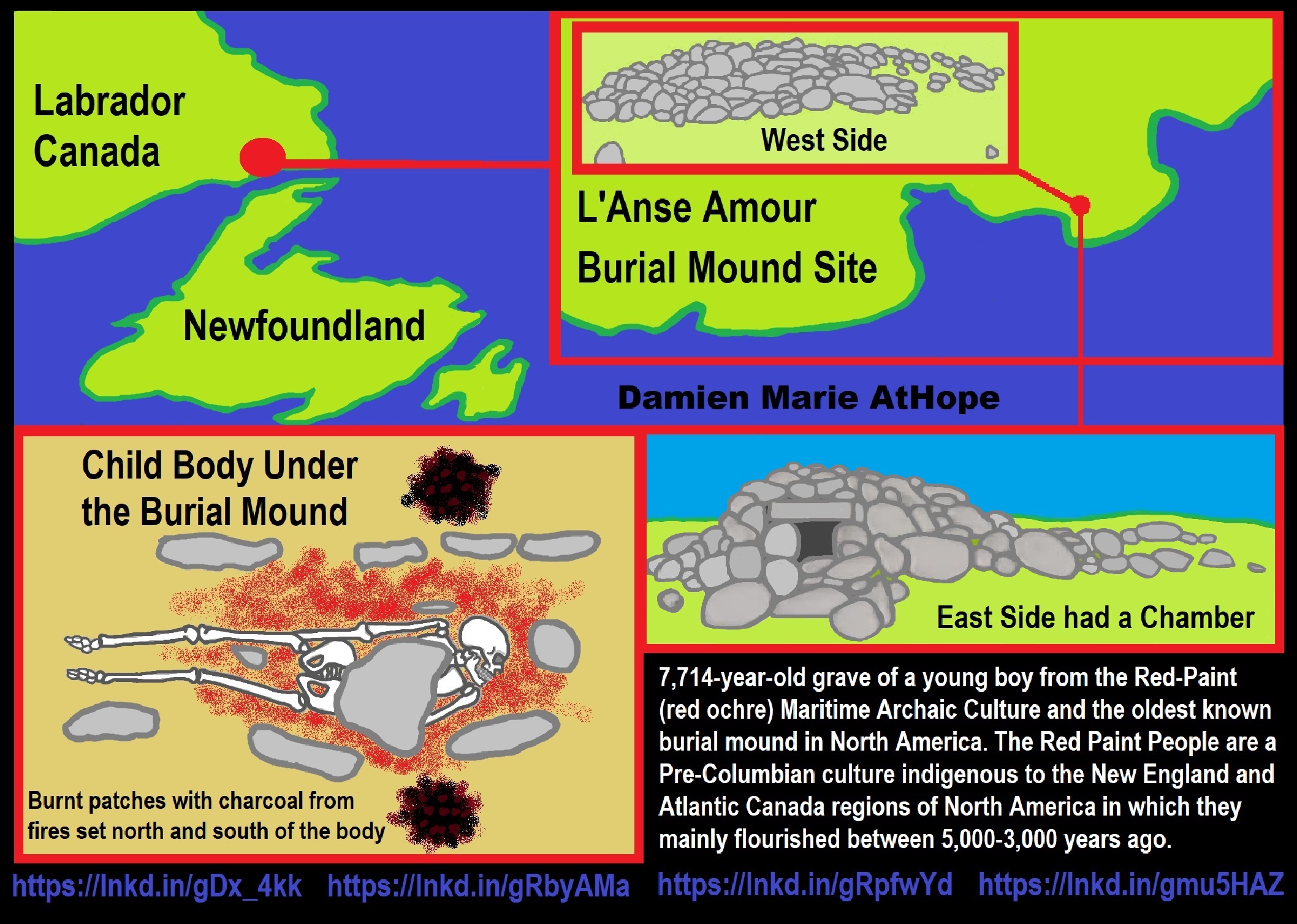
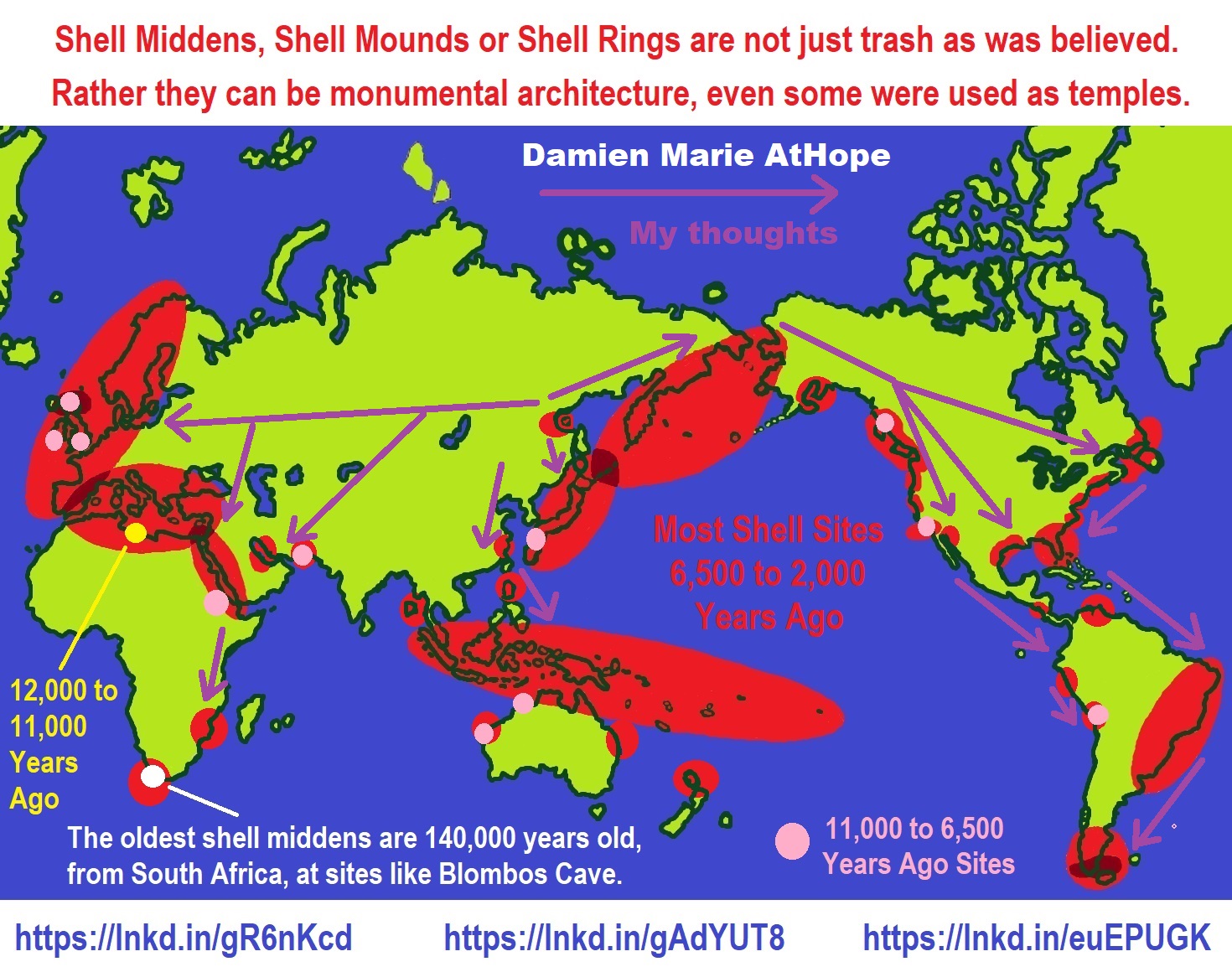

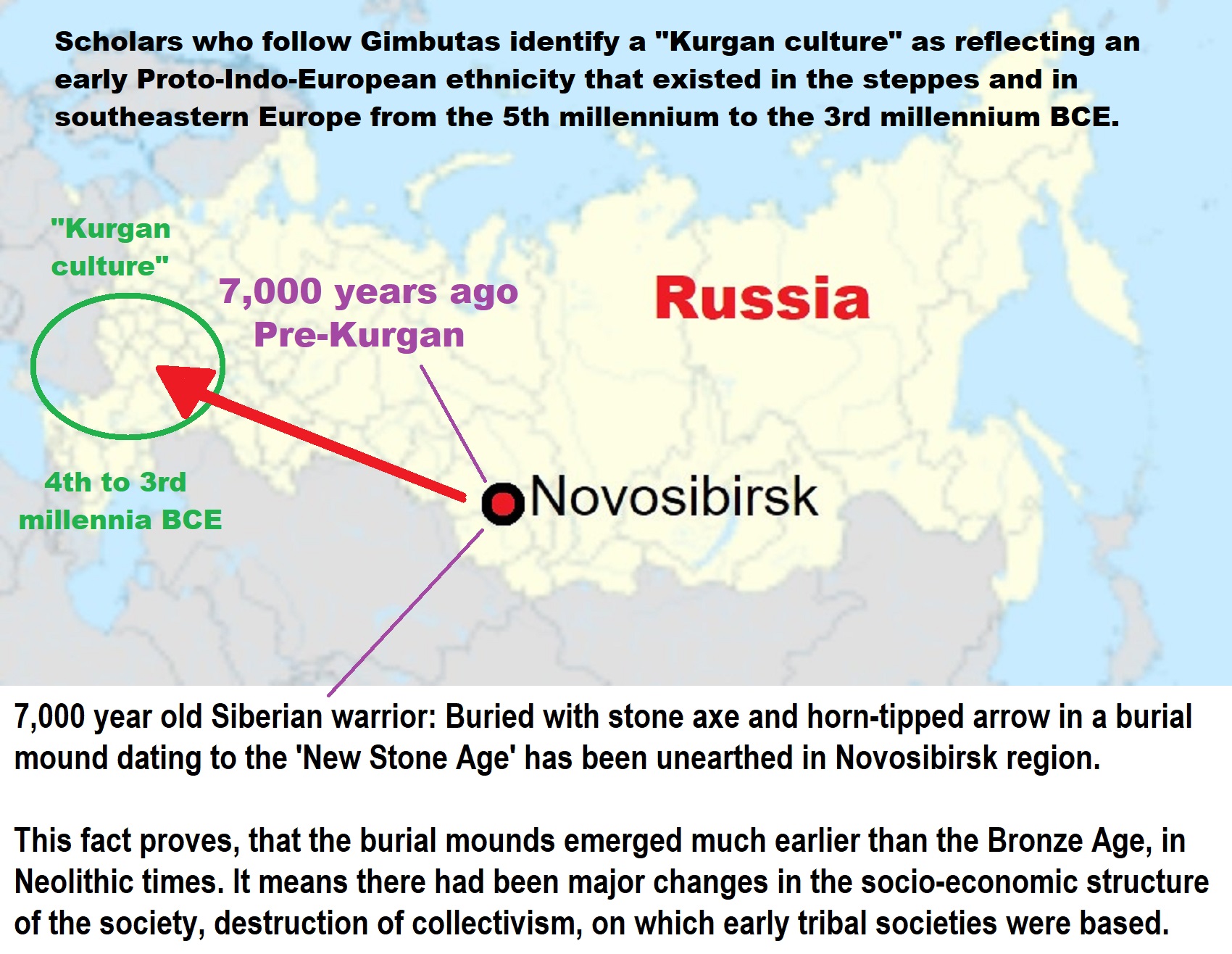
Kurgan Hypothesis
“The Kurgan hypothesis (also known as the Kurgan theory or Kurgan model) or Steppe theory is the most widely accepted proposal to identify the Proto-Indo-European homeland from which the Indo-European languages spread out throughout Europe and parts of Asia. It postulates that the people of a Kurgan culture in the Pontic steppe north of the Black Sea were the most likely speakers of the Proto-Indo-European language (PIE). The term is derived from the Russian kurgan (курга́н), meaning tumulus or burial mound. The Steppe theory was first formulated by Otto Schrader (1883) and V. Gordon Childe (1926), then systematized in the 1950s by Marija Gimbutas, who used the term to group various prehistoric cultures, including the Yamnaya (or Pit Grave) culture and its predecessors. In the 2000s, David Anthony instead used the core Yamnaya culture and its relationship with other cultures as a point of reference.” ref
“Gimbutas defined the Kurgan culture as composed of four successive periods, with the earliest (Kurgan I) including the Samara and Seroglazovo cultures of the Dnieper–Volga region in the Copper Age (early 4th millennium BCE). The people of these cultures were nomadic pastoralists, who, according to the model, by the early 3rd millennium BCE had expanded throughout the Pontic–Caspian steppe and into Eastern Europe. Recent genetics studies have demonstrated that populations bearing specific Y-DNA haplogroups and a distinct genetic signature expanded into Europe and South Asia from the Pontic-Caspian steppe during the third and second millennia BCE. These migrations provide a plausible explanation for the spread of at least some of the Indo-European languages, and suggest that the alternative Anatolian hypothesis, which places the Proto-Indo-European homeland in Neolithic Anatolia, is less likely to be correct.” ref
“Cultures that Gimbutas considered as part of the “Kurgan culture”:
- Bug–Dniester (6th millennium)
- Samara (5th millennium)
- Khvalynsk (5th millennium)
- Dnieper–Donets (5th to 4th millennia)
- Sredny Stog (mid-5th to mid-4th millennia)
- Maikop–Dereivka (mid-4th to mid-3rd millennia)
- Yamnaya (Pit Grave): This is itself a varied cultural horizon, spanning the entire Pontic–Caspian steppe from the mid-4th to the 3rd millennium.
- Usatovo culture (late 4th millennium)” ref
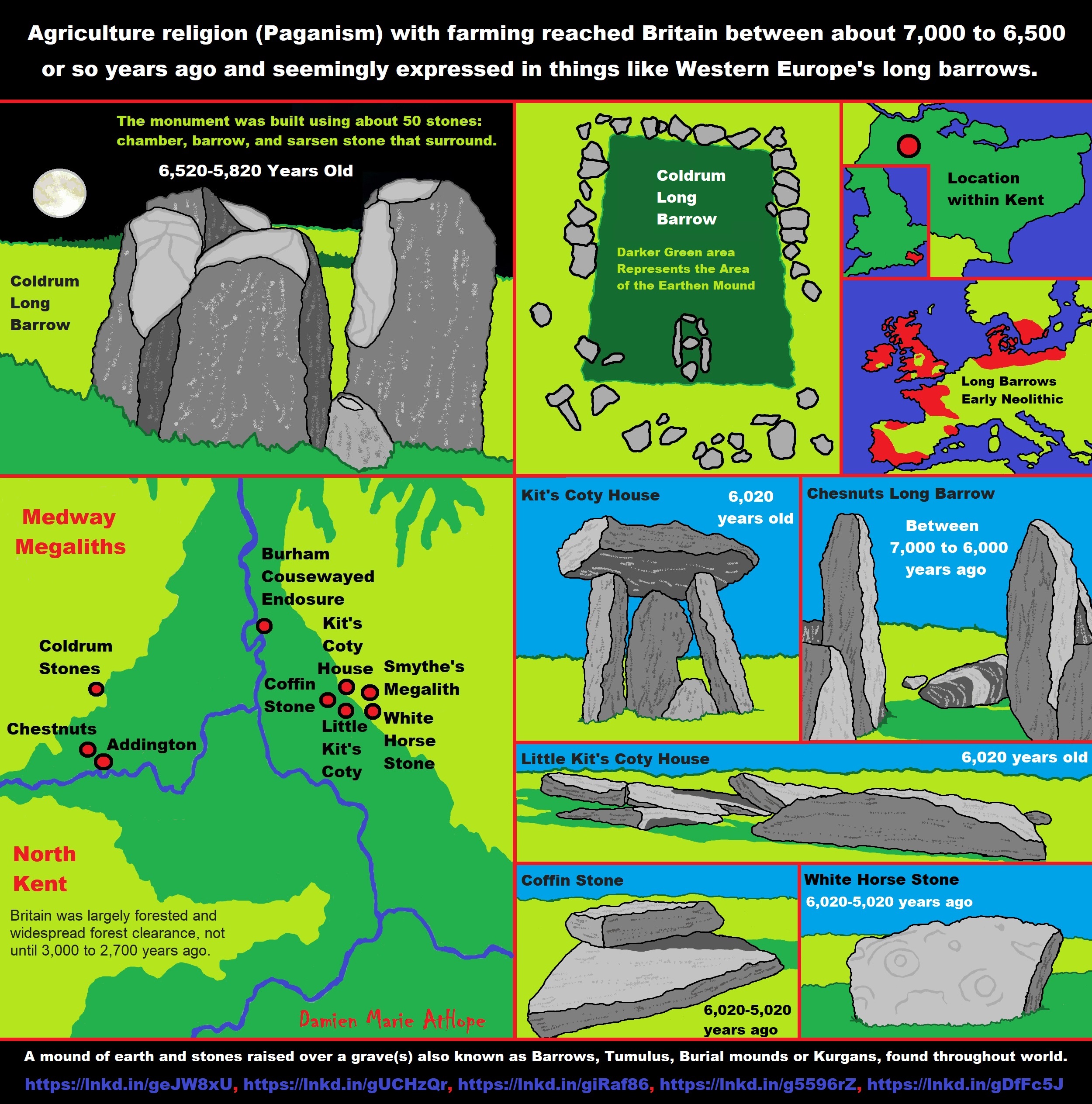
The earliest known dolmens are dated to the 7,000 years ago in Brittany, France’s northwesternmost region.
“Astronomers are exploring what might be described as the first astronomical observing tool, potentially used by prehistoric humans 6,000 years ago in Portugal. They suggest that the long, narrow entrance passages to ancient stone, or ‘megalithic’, tombs may have enhanced what early human cultures could see in the night sky, an effect that could have been interpreted as the ancestors granting special power to the initiated.” – ref
Dolmens used in this way seems like the features found in some pyramids, aiming to the stars that could have been thought to actually be ancestors or the place they go as in a possible reason to think ghosts live in the skies, that could relate to things like the zodiac. Could this also relate in some way to ‘Sky Burial’ theory and its possible origins at least 12,000 years ago to likely 30,000 years ago or older. The dolmens reached Britain, Ireland and southern Scandinavia about 6,000 years ago. Sites in central and southern Europe were constructed at a similar date. They are generally all regarded as tombs or burial chambers, despite the absence of clear evidence for this. Human remains, sometimes accompanied by artefacts, have been found in or close to the dolmens which could be scientifically dated using radiocarbon dating. However, it has been impossible to prove that these remains date from the time when the stones were originally set in place. A dolmen is a type of single-chamber megalithic, usually consisting of two or more vertical megaliths stones supporting a large flat horizontal capstone or “table”. ref
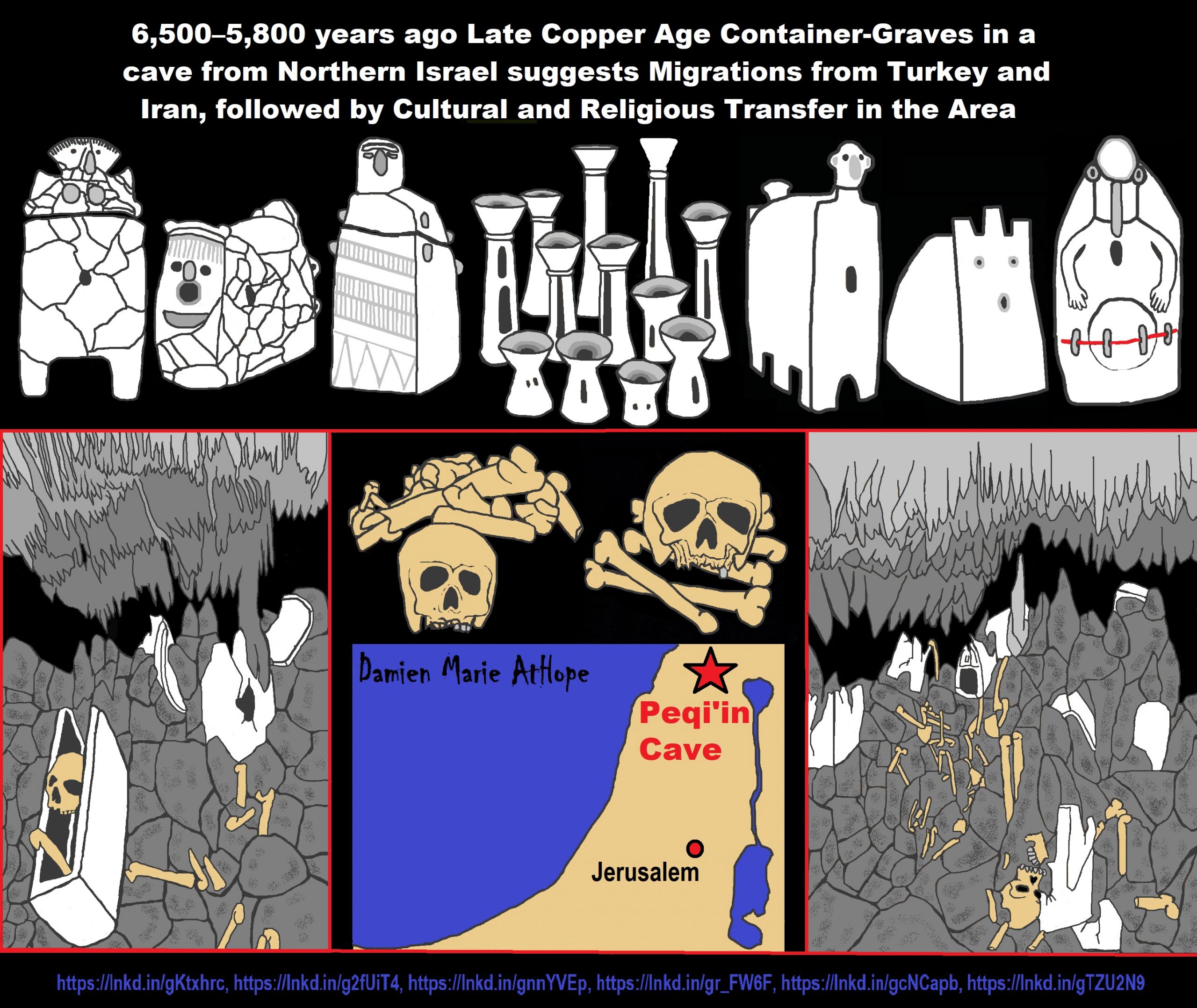
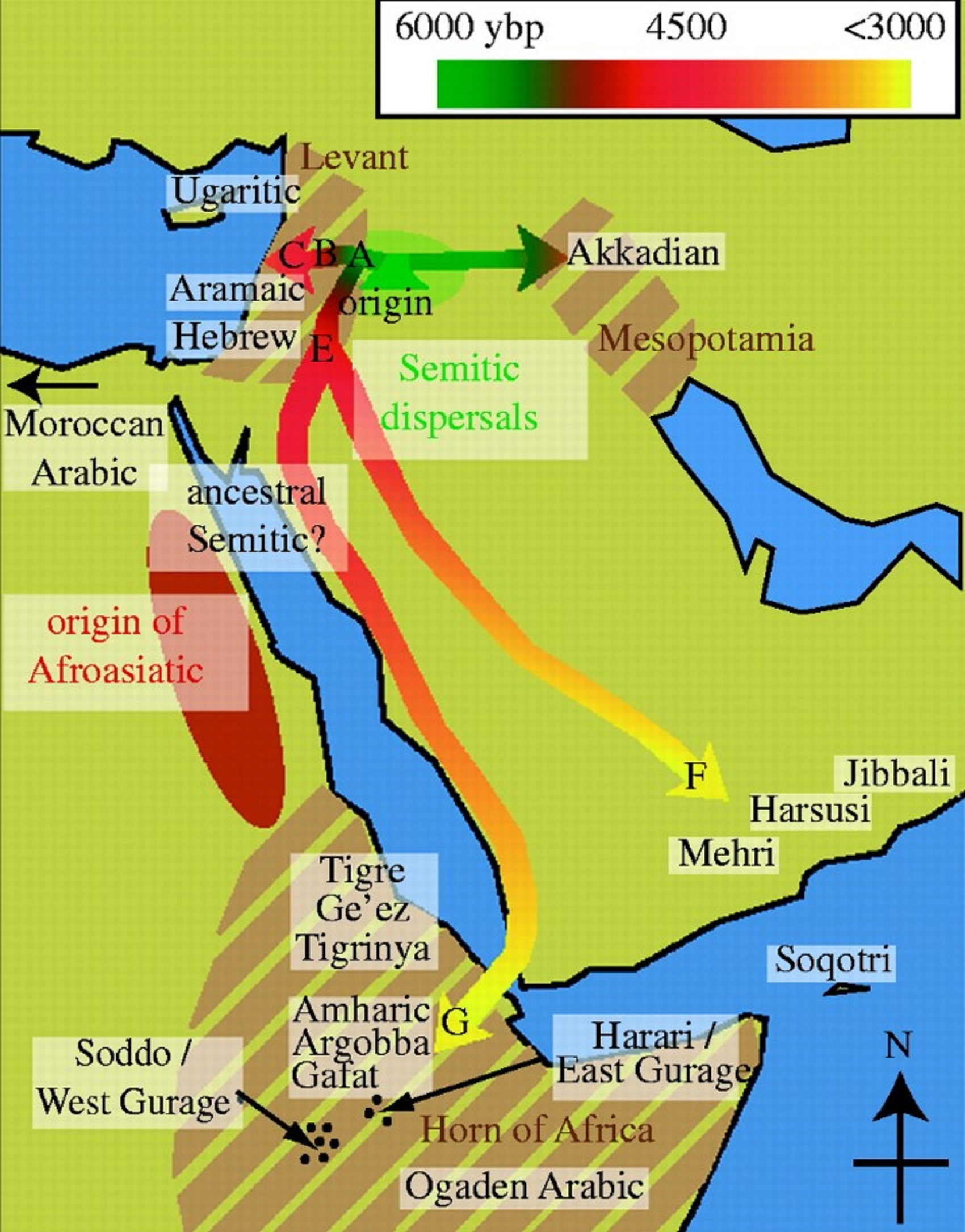
“Proto-Semitic ca. 4500-3500 BCE is the hypothetically reconstructed proto-language ancestral to the Semitic languages. A Bayesian analysis performed in 2009 suggests an origin for all known Semitic languages in the Levant around 3750 BCE, with a later single introduction from South Arabia into the Horn of Africa around 800 BCE. This statistical analysis could not, however, estimate when or where the ancestor of all Semitic languages diverged from Afroasiatic. It thus neither contradicts nor confirms the hypothesis that the divergence of ancestral Semitic from Afroasiatic occurred in Africa.” ref
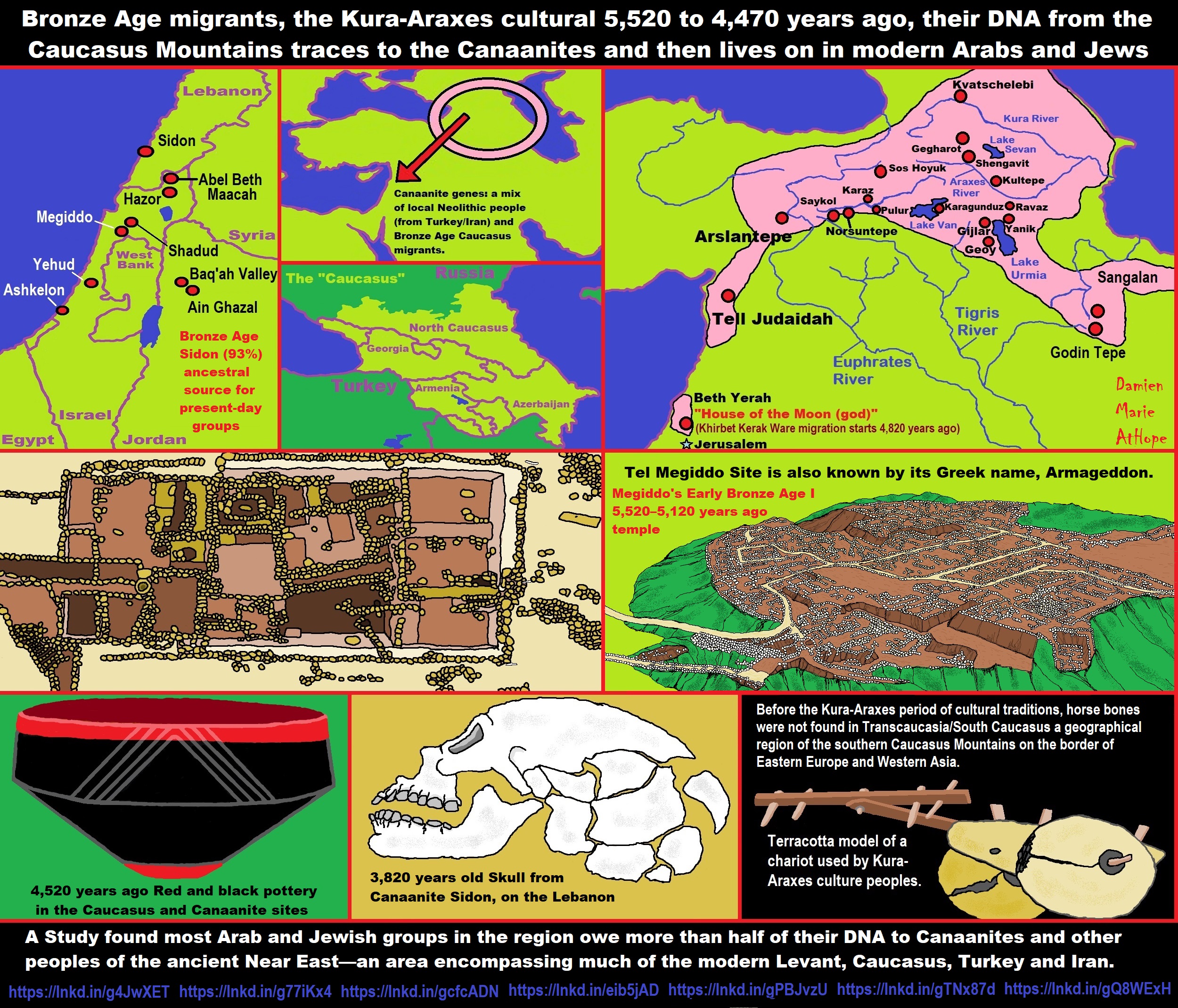
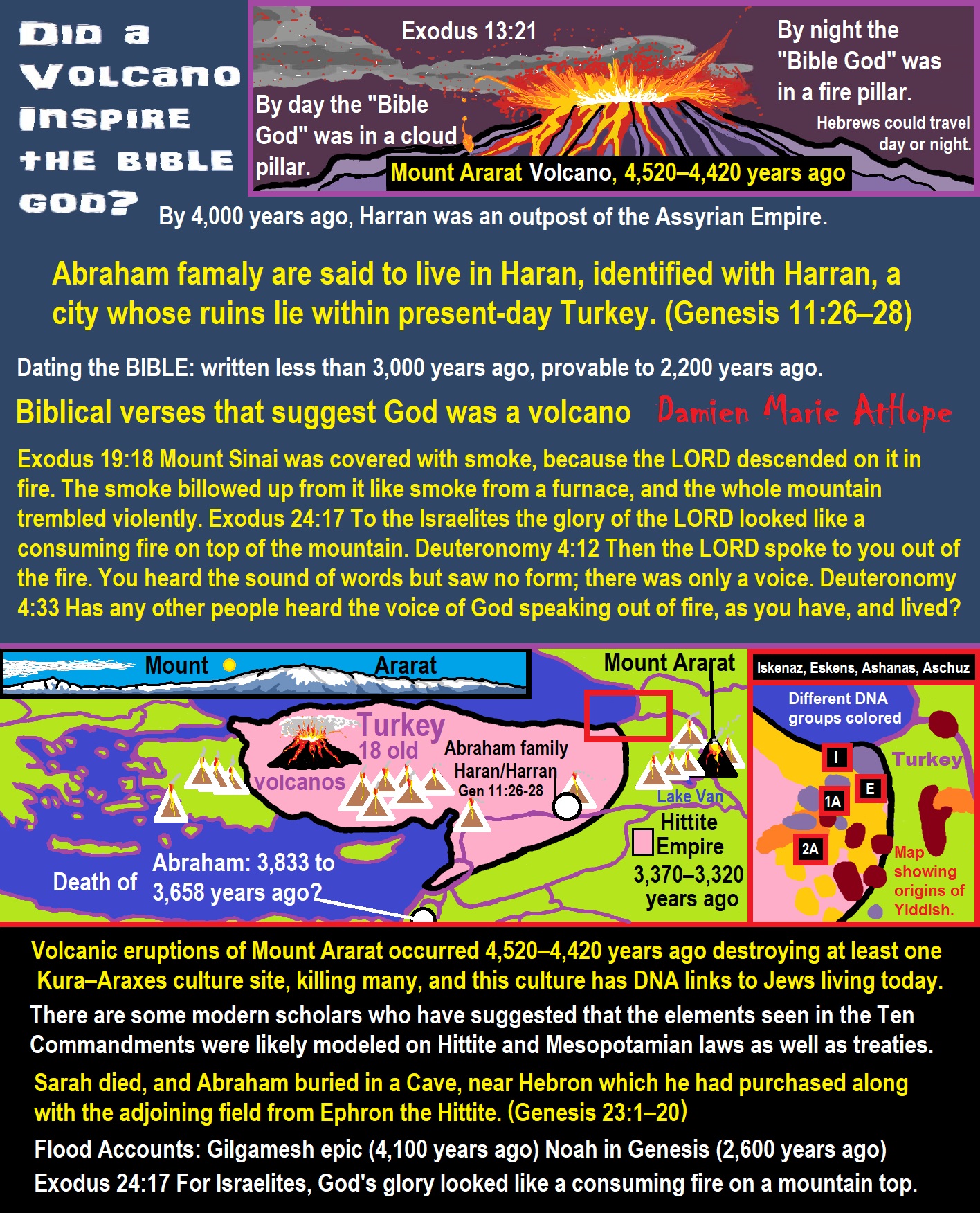
ref, ref, ref, ref, ref, ref, ref, ref, ref, ref, ref, ref, ref
By day the LORD went ahead of them in a pillar of cloud to guide them on their way and by night in a pillar of fire to give them light, so that they could travel by day or night.
- By day the “Bible God” was in a cloud pillar.
- By night the “Bible God” was in a fire pillar.
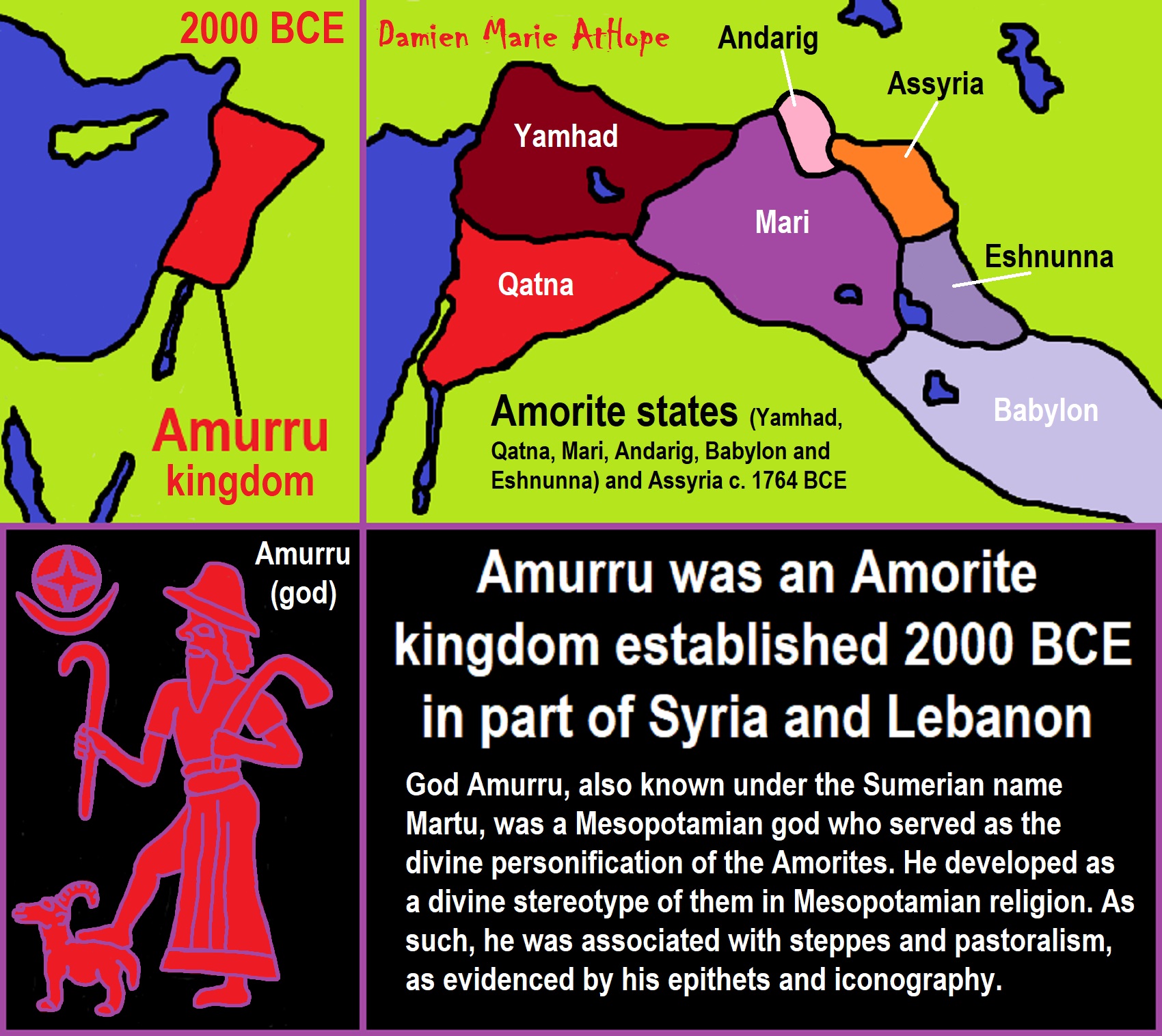
Amorites and Semitic languages
“The earliest attestations of a Semitic language are in Akkadian, dating to around the 24th to 23rd centuries BCE (see Sargon of Akkad) and the Eblaite language, but earlier evidence of Akkadian comes from personal names in Sumerian texts from the first half of the third millennium BCE. One of the earliest known Akkadian inscriptions was found on a bowl at Ur, addressed to the very early pre-Sargonic king Meskiagnunna of Ur (c. 2485–2450 BCE) by his queen Gan-saman, who is thought to have been from Akkad. The earliest text fragments of West Semitic are snake spells in Egyptian pyramid texts, dated around the mid-third millennium BCE.” ref
“Semitic languages occur in written form from a very early historical date in West Asia, with East Semitic Akkadian and Eblaite texts (written in a script adapted from Sumerian cuneiform) appearing from the 30th century BCE and the 25th century BCE in Mesopotamia and the north eastern Levant respectively. The only earlier attested languages are Sumerian and Elamite (2800 to 550 BCE), both language isolates, and Egyptian (a sister branch of the Afroasiatic family, related to the Semitic languages but not part of them).” ref
“Amorite appeared in Mesopotamia and the northern Levant circa 2000 BCE, followed by the mutually intelligible Canaanite languages (including Hebrew, Phoenician, Moabite, Edomite and Ammonite, and perhaps Ekronite, Amalekite and Sutean), the still spoken Aramaic, and Ugaritic during the 2nd millennium BCE. Most scripts used to write Semitic languages are abjads – a type of alphabetic script that omits some or all of the vowels, which is feasible for these languages because the consonants are the primary carriers of meaning in the Semitic languages. These include the Ugaritic, Phoenician, Aramaic, Hebrew, Syriac, Arabic, and ancient South Arabian alphabets.” ref
“The Amorites were an ancient Northwest Semitic-speaking people from the Levant who also occupied large parts of southern Mesopotamia from the 21st century BCE to the end of the 17th century BCE, where they established several prominent city-states in existing locations, such as Isin, Larsa, and later notably Babylon, which was raised from a small town to an independent state and a major city. The term Amurru in Akkadian and Sumerian texts refers to the Amorites, their principal deity, and an Amorite kingdom. The Amorites are also mentioned in the Bible as inhabitants of Canaan both before and after the conquest of the land under Joshua.” ref
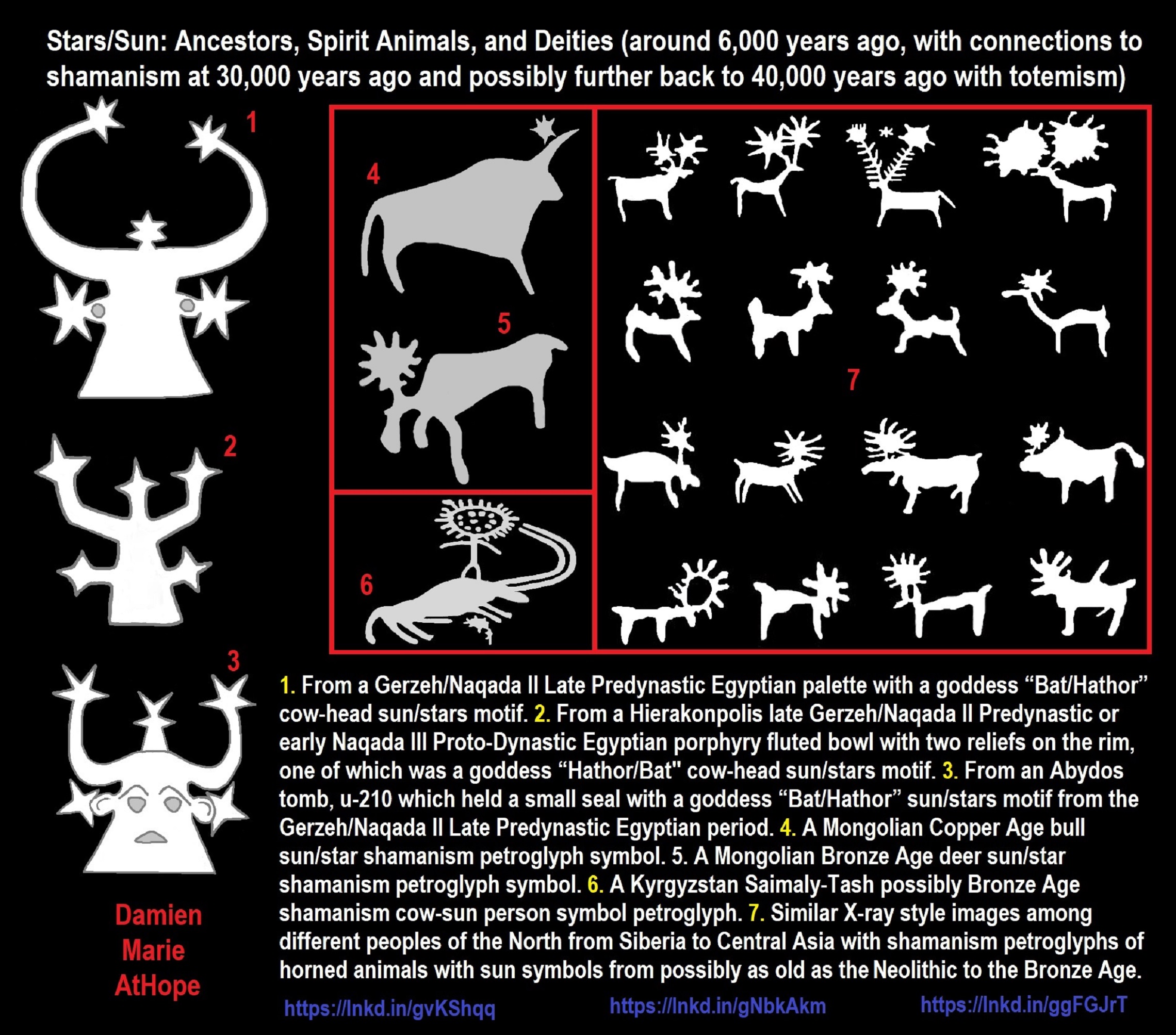
- From a Gerzeh/Naqada II Late Predynastic Egyptian palette with a goddess “Bat/Hathor” cow-head sun/stars motif.
- From a Hierakonpolis late Gerzeh/Naqada II Predynastic or early Naqada III Proto-Dynastic Egyptian porphyry fluted bowl with two reliefs on the rim, one of which was a goddess “Hathor/Bat” cow-head sun/stars motif.
- From an Abydos tomb, u-210 which held a small seal with a goddess “Bat/Hathor” sun/stars motif from the Gerzeh/Naqada II Late Predynastic Egyptian period.
- A Mongolian Copper Age bull sun/star shamanism petroglyph
- A Mongolian Bronze Age deer sun/star shamanism petroglyph symbol.
- A Kyrgyzstan Saimaly-Tash possibly Bronze Age shamanism cow-sun person symbol petroglyph.
- Similar X-ray style images among different peoples of the North from Siberia to Central Asia with shamanism petroglyphs of horned animals with sun symbols from possibly as old as the Neolithic to the Bronze Age. ref, ref, ref
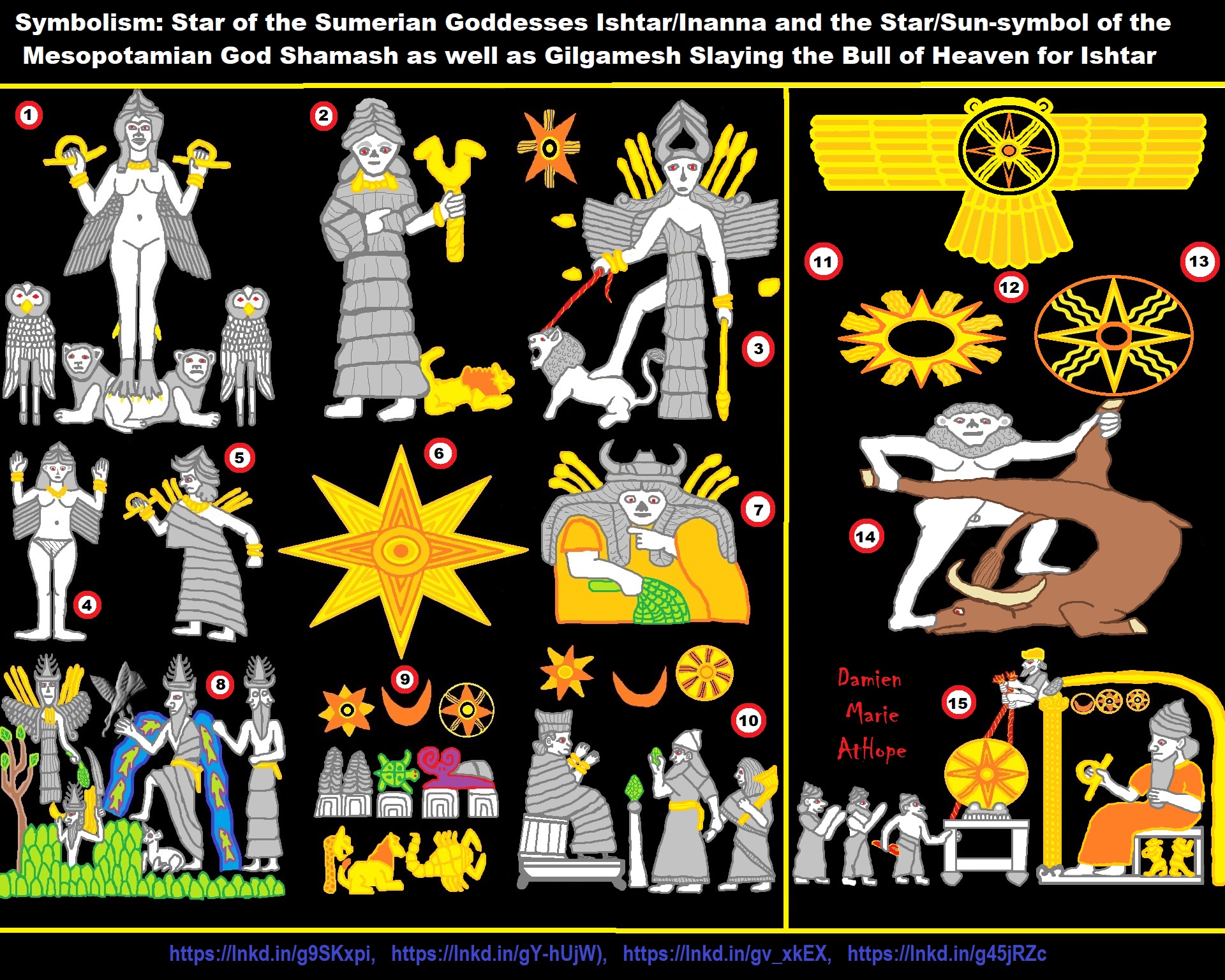
ref, ref, ref, ref, ref, ref, ref, ref, ref
“The Ghassulian Star,” a mysterious 6,000-year-old mural from Jordan; a Proto-Star of Ishtar, Star of Inanna or Star of Venus?
Yes, I believe they may be, and to me, thus possibly could have some connections to the central Asain deity Tian which may also be related to Tengri.
Goddesses Ishtar/Inanna were worshipped in Sumer at least as early as the Uruk period (6000 – 5,100 years ago). ref
“The Ghassulian Star,” a mysterious 6,000-year-old mural from Jordan. “The Ghassulian Star” was made before people could write, back when everyone either hunted and gathered or lived in small farming villages. The figures were painted with black, brown, red, white and yellow natural mineral paints; mud and lime walls were the canvas. The painting features a giant star, animals and masked figures sporting what look a lot like googly eyes. ref
“Ghassulian refers to a culture and an archaeological stage dating to the Middle and Late Chalcolithic Period in the Southern Levant (6,400 – 5,500 years ago). Its type-site, Teleilat Ghassul (Teleilat el-Ghassul, Tulaylat al-Ghassul), is located in the eastern Jordan Valley near the northern edge of the Dead Sea, in modern Jordan.” ref
“The Ghassulian stage was characterized by small hamlet settlements of mixed farming peoples, who had immigrated from the north and settled in the southern Levant – today’s Jordan, Israel and Palestine. People of the Beersheba Culture (a Ghassulian subculture) lived in underground dwellings – a unique phenomenon in the archaeological history of the region – or in houses that were trapezoid-shaped and built of mud-brick. Those were often built partially underground (on top of collapsed underground dwellings) and were covered with remarkable polychrome wall paintings.” ref
“Their pottery was highly elaborate, including footed bowls and horn-shaped drinking goblets, indicating the cultivation of wine. Several samples display the use of sculptural decoration or of a reserved slip (a clay and water coating partially wiped away while still wet). The Ghassulians were a Chalcolithic culture as they used stone tools but also smelted copper. Funerary customs show evidence that they buried their dead in stone dolmens and also practiced Secondary burial. Settlements belonging to the Ghassulian culture have been identified at numerous other sites in what is today southern Israel, especially in the region of Beersheba, where elaborate underground dwellings have been excavated. The Ghassulian culture correlates closely with the Amratian of Egypt and also seems to have affinities (e.g., the distinctive churns, or “bird vases”) with early Minoan culture in Crete.” ref
“Between 5,800 – 5,350 years ago, the Ghassulian culture emerged based on an economy specializing in smelting the copper that Sumerian (Uruk) cities imported from the Southern Levant and the Upper Euphrates. The Ghassulians also erected dolmen monuments, similar to megalithic burial structures found not only in Western Europe, but also in the Western Caucasus. An unexpected link with the Uruk dispersions of the Caucasus has been suggested for the Nahal Mishmar “Cave of the Treasure” discovered in the Judean Desert. The fine metalwork discovered in this desert cache includes pieces crafted in a long period 7,000 – 5,500 years ago, as if this cache was buried to protect valuable cultural artifacts (possibly from temple sites) from robbers during the Ubaid-Uruk transition period.” ref
“Adding to the archaeological mystery, the only comparable metalwork from this period has been discovered far away in the Maykop burial north of the Black Sea. Archaeologists have also suggested Ghassulian contacts with the Aegean and Upper Egypt (Amratian culture), suggesting that these East Mediterranean copper smelters played a dynamic role connecting far-flung cultures. Notably, the Ghassulian culture flourished at the time and location some linguists have suggested the Proto-Semitic languages first emerged (approximately 5,750 years ago, probably in the East Mediterranean).5 These later developed to become the Ugaritic, Phoenician, and Hebrew languages spoken not only in Canaan, but also throughout the Mediterranean, Arabian Peninsula, and the Horn of Africa. In Europe, this period was less favorable. The “Old European” civilization of the CBMP dissolved between 5,500 – 5,200 years ago, partly regrouping near the Aegean Sea (preserving the foundations for the seagoing Minoan-Mycenaean civilizations), and some adapting to new pastoral lifeways near the Black Sea (such as the Usatovo culture.” ref
“Despite the centrality of ancient Sumer, early Mesopotamia has rarely been discussed in the context of human genetic structure, and the effects of Sumerian expansions in reshaping the world genetic landscape remain to be discovered. However, the potential of urban centers using new technological toolkits (fueling population growth and giving an early demographic advantage over neighboring Mesolithic societies) suggests that Sumer might have played a formative role in West Eurasian demographic history. To help establish a historical foundation for examining the multi-layered genetic structure of the Middle East, this article will outline three phases of Sumerian civilization: (1) Founding of urban settlements during the Ubaid period; (2) Dispersion of Sumerian populations to the Caucasus Mountains and Asia during the Uruk period (including related Kura-Araxes migrations, possibly related to the spread of satem IE languages); and (3) Back-migrations to the Fertile Crescent (in response to events at the periphery of the Sumerian world) during the Middle Bronze Age.” ref
“Ubaid Period Foundations (8,500 – 5,800 years ago). The foundations of Sumerian civilization were laid during the Ubaid Period (8,500 – 5,800 years ago). In this period, the first Mesopotamian cities were founded, starting with the world’s first capital, Eridu. Probably under the guidance of a priestly bureaucratic elite, these settlements were organized in a tripartite hereditary social structure: integrating farm laborers, nomadic pastoralists (animal herders), and hunting-fishing peoples as urban citizens. This urban culture spread outwards to establish a vast “Ubaid horizon” (2,000 km across) between the Mediterranean Sea and the Persian Gulf. The flow of Ubaid material culture stimulated developments in more distant regions. In the Northern Levant, the Ubaid civilization absorbed neighboring Halaf dry farming (non-irrigation) settlements (perhaps Afroasiatic speaking predecessors of the Akkadians and Assyrians).” ref
“Reaching even further beyond these rivers, Ubaid related (Hassuna-Samarra) pottery types and clay artwork have been found throughout the Aegean, Anatolia, and East Mediterranean. According to the archaeologist Marija Gimbutas, these shared craft forms appeared simultaneously in Southeastern Europe and West Asia around 8,700 – 8,500 years ago. Map of West Eurasian cultures during the Ubaid period. Sumer (the Ubaid heartland) is highlighted in red. Possible language families in neighboring areas are listed in italics. In Europe, this Ubaid related material culture was the basis of what Gimbutas dubbed the “Old European” civilization of the Balkan Peninsula and Central Europe, later splitting into local variant traditions around 7,000 years ago. More recently, Evgeny Chernykh has documented evidence for a large Carpatho-Balkan Metallurgical Province composed of densely settled communities (of up to 15,000 people each) connected by shared copper technology. This network of settlements flourished between 7,500 – 5,500 years ago, before dissolving around 5,200 years ago.” ref
“In the later part of the Ubaid period, another peripheral Copper Age culture emerged in South Asia: the Mehrgarh III or Togau Phase (6,300 – 5,800 years ago) that brought an influx of new collective burial customs, ceramic styles, and copper technology (possibly from West Asia). Other cultural centers that emerged during the Ubaid period included Nabta Playa in Africa, possibly constructed by early populations of the “Green Sahara” (Neolithic Subpluvial; 9,000 – 5,500 years ago), when the landscape of Northern Africa resembled the ecologically rich savannahs of present-day Kenya, and the Badarian and Amratian (Predynastic Upper Egyptian) cultures emerged along the Nile River. Because of their “early adopter” status, these dense Ubaid period settlements in Mesopotamia, Southeastern Europe, and South Asia potentially played a key role in shaping later demographic history. The Kurgan Culture and the Indo-Europeanization of Europe considered the Chalcolithic “Old European” civilization pre-IE and suggested that the Proto-Indo-European (IE) languages emerged only later with “Kurgan” culture of the Eurasian steppe.” ref
“However, this article suggests instead that the Proto-Indo-European language emerged in Ubaid period Southeastern Europe (possibly derived from older West Asian Indo-Hittite languages), later diverging into Eurasian satem and Mediterranean centum IE varieties after the collapse of the CBMP around 5,200 years ago. This would be consistent with linguistic evidence for PIE origins around 6,000 years ago and early contacts with the Uralic (North Eurasian), Caucasian (West Asian), and Afroasiatic (East Mediterranean) languages in West Eurasia. However, it is probable that no modern culture fully represents these ancestral founding populations. Nevertheless, traces of this ancestral population structure might to some extent be preserved in West Asian populations with a tradition of endogamy (such as Assyrian Christians, Druze, etc.). However, ancient DNA would be needed to examine these relationships in more detail.” ref
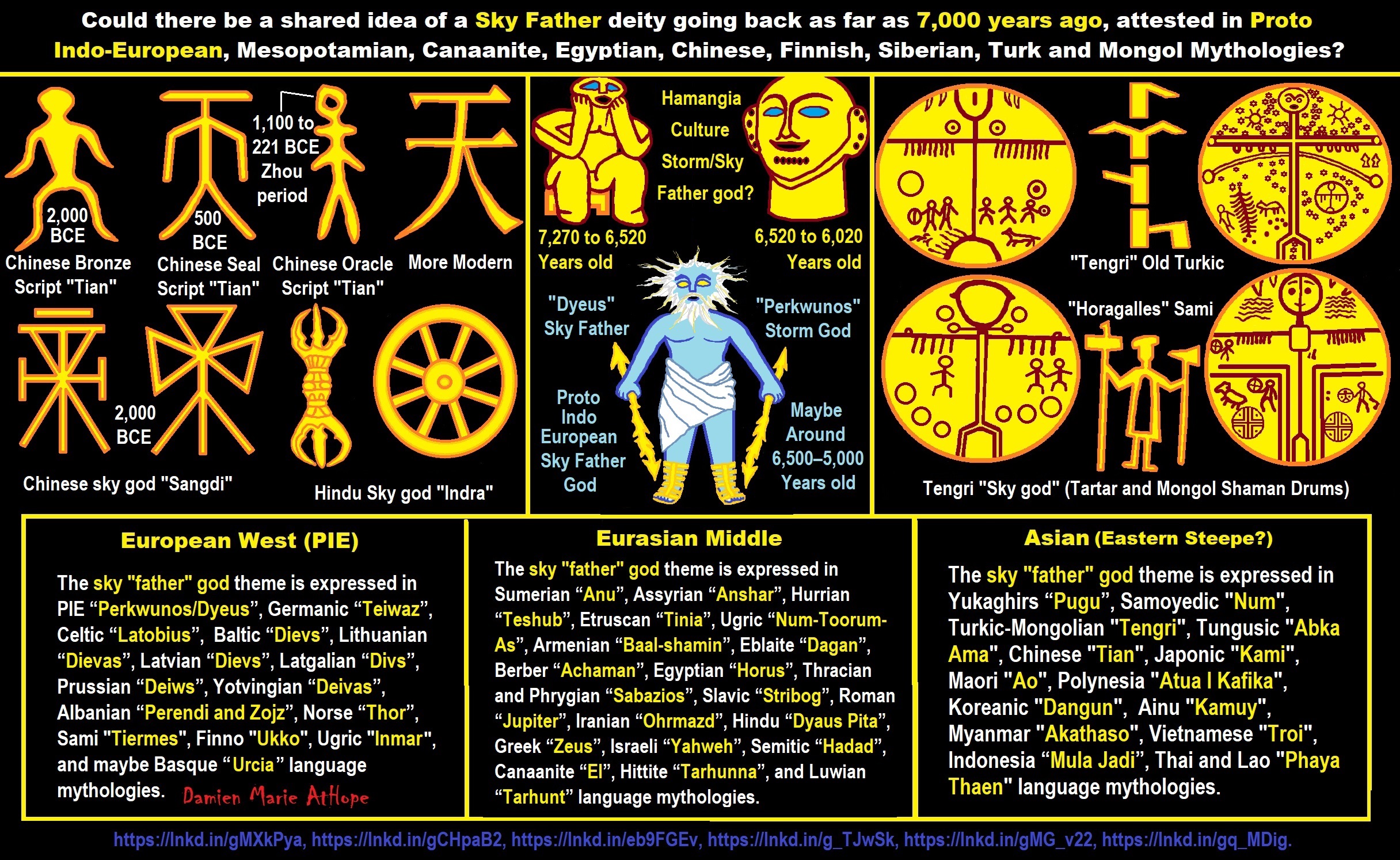



Animism: Respecting the Living World by Graham Harvey
“How have human cultures engaged with and thought about animals, plants, rocks, clouds, and other elements in their natural surroundings? Do animals and other natural objects have a spirit or soul? What is their relationship to humans? In this new study, Graham Harvey explores current and past animistic beliefs and practices of Native Americans, Maori, Aboriginal Australians, and eco-pagans. He considers the varieties of animism found in these cultures as well as their shared desire to live respectfully within larger natural communities. Drawing on his extensive casework, Harvey also considers the linguistic, performative, ecological, and activist implications of these different animisms.” ref


My thoughts on Religion Evolution with external links for more info:
- (Pre-Animism Africa mainly, but also Europe, and Asia at least 300,000 years ago), (Pre-Animism – Oxford Dictionaries)
- (Animism Africa around 100,000 years ago), (Animism – Britannica.com)
- (Totemism Europe around 50,000 years ago), (Totemism – Anthropology)
- (Shamanism Siberia around 30,000 years ago), (Shamanism – Britannica.com)
- (Paganism Turkey around 12,000 years ago), (Paganism – BBC Religion)
- (Progressed Organized Religion “Institutional Religion” Egypt around 5,000 years ago), (Ancient Egyptian Religion – Britannica.com)
- (CURRENT “World” RELIGIONS after 4,000 years ago) (Origin of Major Religions – Sacred Texts)
- (Early Atheistic Doubting at least by 2,600 years ago) (History of Atheism – Wikipedia)
“Religion is an Evolved Product” and Yes, Religion is Like Fear Given Wings…
Atheists talk about gods and religions for the same reason doctors talk about cancer, they are looking for a cure, or a firefighter talks about fires because they burn people and they care to stop them. We atheists too often feel a need to help the victims of mental slavery, held in the bondage that is the false beliefs of gods and the conspiracy theories of reality found in religions.
Understanding Religion Evolution:
- Pre-Animism (at least 300,000 years ago)
- Animism (Africa: 100,000 years ago)
- Totemism (Europe: 50,000 years ago)
- Shamanism (Siberia: 30,000 years ago)
- Paganism (Turkey: 12,000 years ago)
- Progressed organized religion (Egypt: 5,000 years ago), (Egypt, the First Dynasty 5,150 years ago)
- CURRENT “World” RELIGIONS (after 4,000 years ago)
- Early Atheistic Doubting (at least by 2,600 years ago)
“An Archaeological/Anthropological Understanding of Religion Evolution”
It seems ancient peoples had to survived amazing threats in a “dangerous universe (by superstition perceived as good and evil),” and human “immorality or imperfection of the soul” which was thought to affect the still living, leading to ancestor worship. This ancestor worship presumably led to the belief in supernatural beings, and then some of these were turned into the belief in gods. This feeble myth called gods were just a human conceived “made from nothing into something over and over, changing, again and again, taking on more as they evolve, all the while they are thought to be special,” but it is just supernatural animistic spirit-belief perceived as sacred.
Quick Evolution of Religion?
Pre-Animism (at least 300,000 years ago) pre-religion is a beginning that evolves into later Animism. So, Religion as we think of it, to me, all starts in a general way with Animism (Africa: 100,000 years ago) (theoretical belief in supernatural powers/spirits), then this is physically expressed in or with Totemism (Europe: 50,000 years ago) (theoretical belief in mythical relationship with powers/spirits through a totem item), which then enlists a full-time specific person to do this worship and believed interacting Shamanism (Siberia/Russia: 30,000 years ago) (theoretical belief in access and influence with spirits through ritual), and then there is the further employment of myths and gods added to all the above giving you Paganism (Turkey: 12,000 years ago) (often a lot more nature-based than most current top world religions, thus hinting to their close link to more ancient religious thinking it stems from). My hypothesis is expressed with an explanation of the building of a theatrical house (modern religions development). Progressed organized religion (Egypt: 5,000 years ago) with CURRENT “World” RELIGIONS (after 4,000 years ago).
Historically, in large city-state societies (such as Egypt or Iraq) starting around 5,000 years ago culminated to make religion something kind of new, a sociocultural-governmental-religious monarchy, where all or at least many of the people of such large city-state societies seem familiar with and committed to the existence of “religion” as the integrated life identity package of control dynamics with a fixed closed magical doctrine, but this juggernaut integrated religion identity package of Dogmatic-Propaganda certainly did not exist or if developed to an extent it was highly limited in most smaller prehistoric societies as they seem to lack most of the strong control dynamics with a fixed closed magical doctrine (magical beliefs could be at times be added or removed). Many people just want to see developed religious dynamics everywhere even if it is not. Instead, all that is found is largely fragments until the domestication of religion.
Religions, as we think of them today, are a new fad, even if they go back to around 6,000 years in the timeline of human existence, this amounts to almost nothing when seen in the long slow evolution of religion at least around 70,000 years ago with one of the oldest ritual worship. Stone Snake of South Africa: “first human worship” 70,000 years ago. This message of how religion and gods among them are clearly a man-made thing that was developed slowly as it was invented and then implemented peace by peace discrediting them all. Which seems to be a simple point some are just not grasping how devastating to any claims of truth when we can see the lie clearly in the archeological sites.
I wish people fought as hard for the actual values as they fight for the group/clan names political or otherwise they think support values. Every amount spent on war is theft to children in need of food or the homeless kept from shelter.
Here are several of my blog posts on history:
- To Find Truth You Must First Look
- (Magdalenian/Iberomaurusian) Connections to the First Paganists of the early Neolithic Near East Dating from around 17,000 to 12,000 Years Ago
- Natufians: an Ancient People at the Origins of Agriculture and Sedentary Life
- Possible Clan Leader/Special “MALE” Ancestor Totem Poles At Least 13,500 years ago?
- Jewish People with DNA at least 13,200 years old, Judaism, and the Origins of Some of its Ideas
- Baltic Reindeer Hunters: Swiderian, Lyngby, Ahrensburgian, and Krasnosillya cultures 12,020 to 11,020 years ago are evidence of powerful migratory waves during the last 13,000 years and a genetic link to Saami and the Finno-Ugric peoples.
- The Rise of Inequality: patriarchy and state hierarchy inequality
- Fertile Crescent 12,500 – 9,500 Years Ago: fertility and death cult belief system?
- 12,400 – 11,700 Years Ago – Kortik Tepe (Turkey) Pre/early-Agriculture Cultic Ritualism
- Ritualistic Bird Symbolism at Gobekli Tepe and its “Ancestor Cult”
- Male-Homosexual (female-like) / Trans-woman (female) Seated Figurine from Gobekli Tepe
- Could a 12,000-year-old Bull Geoglyph at Göbekli Tepe relate to older Bull and Female Art 25,000 years ago and Later Goddess and the Bull cults like Catal Huyuk?
- Sedentism and the Creation of goddesses around 12,000 years ago as well as male gods after 7,000 years ago.
- Alcohol, where Agriculture and Religion Become one? Such as Gobekli Tepe’s Ritualistic use of Grain as Food and Ritual Drink
- Neolithic Ritual Sites with T-Pillars and other Cultic Pillars
- Paganism: Goddesses around 12,000 years ago then Male Gods after 7,000 years ago
- First Patriarchy: Split of Women’s Status around 12,000 years ago & First Hierarchy: fall of Women’s Status around 5,000 years ago.
- Natufians: an Ancient People at the Origins of Agriculture and Sedentary Life
- J DNA and the Spread of Agricultural Religion (paganism)
- Paganism: an approximately 12,000-year-old belief system
- Paganism 12,000 years old: related to “Anarchism and Socialism” (Pre-Capitalism)
- Shaman burial in Israel 12,000 years ago and the Shamanism Phenomena
- Need to Mythicized: gods and goddesses
- 12,000 – 7,000 Years Ago – Paleo-Indian Culture (The Americas)
- 12,000 – 2,000 Years Ago – Indigenous-Scandinavians (Nordic)
- Norse did not wear helmets with horns?
- Pre-Pottery Neolithic Skull Cult around 11,500 to 8,400 Years Ago?
- 10,400 – 10,100 Years Ago, in Turkey the Nevail Cori Religious Settlement
- 9,000-6,500 Years Old Submerged Pre-Pottery/Pottery Neolithic Ritual Settlements off Israel’s Coast
- Catal Huyuk “first religious designed city” around 9,500 to 7,700 years ago (Turkey)
- Cultic Hunting at Catal Huyuk “first religious designed city”
- Special Items and Art as well as Special Elite Burials at Catal Huyuk
- New Rituals and Violence with the appearance of Pottery and People?
- Haplogroup N and its related Uralic Languages and Cultures
- Ainu people, Sámi people, Native Americans, the Ancient North Eurasians, and Paganistic-Shamanism with Totemism
- Ideas, Technology and People from Turkey, Europe, to China and Back again 9,000 to 5,000 years ago?
- First Pottery of Europe and the Related Cultures
- 9,000 years old Neolithic Artifacts Judean Desert and Hills Israel
- 9,000-7,000 years-old Sex and Death Rituals: Cult Sites in Israel, Jordan, and the Sinai
- 9,000-8500 year old Horned Female shaman Bad Dürrenberg Germany
- Neolithic Jewelry and the Spread of Farming in Europe Emerging out of West Turkey
- 8,600-year-old Tortoise Shells in Neolithic graves in central China have Early Writing and Shamanism
- Swing of the Mace: the rise of Elite, Forced Authority, and Inequality begin to Emerge 8,500 years ago?
- Migrations and Changing Europeans Beginning around 8,000 Years Ago
- My “Steppe-Anatolian-Kurgan hypothesis” 8,000/7,000 years ago
- Around 8,000-year-old Shared Idea of the Mistress of Animals, “Ritual” Motif
- Pre-Columbian Red-Paint (red ochre) Maritime Archaic Culture 8,000-3,000 years ago
- 7,522-6,522 years ago Linear Pottery culture which I think relates to Arcane Capitalism’s origins
- Arcane Capitalism: Primitive socialism, Primitive capital, Private ownership, Means of production, Market capitalism, Class discrimination, and Petite bourgeoisie (smaller capitalists)
- 7,500-4,750 years old Ritualistic Cucuteni-Trypillian culture of Moldova, Romania, and Ukraine
- Roots of a changing early society 7,200-6,700 years ago Jordan and Israel
- Agriculture religion (Paganism) with farming reached Britain between about 7,000 to 6,500 or so years ago and seemingly expressed in things like Western Europe’s Long Barrows
- My Thoughts on Possible Migrations of “R” DNA and Proto-Indo-European?
- “Millet” Spreading from China 7,022 years ago to Europe and related Language may have Spread with it leading to Proto-Indo-European
- Proto-Indo-European (PIE), ancestor of Indo-European languages: DNA, Society, Language, and Mythology
- The Dnieper–Donets culture and Asian varieties of Millet from China to the Black Sea region of Europe by 7,022 years ago
- Kurgan 6,000 years ago/dolmens 7,000 years ago: funeral, ritual, and other?
- 7,020 to 6,020-year-old Proto-Indo-European Homeland of Urheimat or proposed home of their Language and Religion
- Ancient Megaliths: Kurgan, Ziggurat, Pyramid, Menhir, Trilithon, Dolman, Kromlech, and Kromlech of Trilithons
- The Mytheme of Ancient North Eurasian Sacred-Dog belief and similar motifs are found in Indo-European, Native American, and Siberian comparative mythology
- Elite Power Accumulation: Ancient Trade, Tokens, Writing, Wealth, Merchants, and Priest-Kings
- Sacred Mounds, Mountains, Kurgans, and Pyramids may hold deep connections?
- Between 7,000-5,000 Years ago, rise of unequal hierarchy elite, leading to a “birth of the State” or worship of power, strong new sexism, oppression of non-elites, and the fall of Women’s equal status
- Paganism 7,000-5,000 years old: related to “Anarchism and Socialism” (Capitalism) (World War 0) Elite & their slaves
- Hell and Underworld mythologies starting maybe as far back as 7,000 to 5,000 years ago with the Proto-Indo-Europeans?
- The First Expression of the Male God around 7,000 years ago?
- White (light complexion skin) Bigotry and Sexism started 7,000 years ago?
- Around 7,000-year-old Shared Idea of the Divine Bird (Tutelary and/or Trickster spirit/deity), “Ritual” Motif
- Nekhbet an Ancient Egyptian Vulture Goddess and Tutelary Deity
- 6,720 to 4,920 years old Ritualistic Hongshan Culture of Inner Mongolia with 5,000-year-old Pyramid Mounds and Temples
- First proto-king in the Balkans, Varna culture around 6,500 years ago?
- 6,500–5,800 years ago in Israel Late Chalcolithic (Copper Age) Period in the Southern Levant Seems to Express Northern Levant Migrations, Cultural and Religious Transfer
- KING OF BEASTS: Master of Animals “Ritual” Motif, around 6,000 years old or older…
- Around 6000-year-old Shared Idea of the Solid Wheel & the Spoked Wheel-Shaped Ritual Motif
- “The Ghassulian Star,” a mysterious 6,000-year-old mural from Jordan; a Proto-Star of Ishtar, Star of Inanna or Star of Venus?
- Religious/Ritual Ideas, including goddesses and gods as well as ritual mounds or pyramids from Northeastern Asia at least 6,000 years old, seemingly filtering to Iran, Iraq, the Mediterranean, Europe, Egypt, and the Americas?
- Maykop (5,720–5,020 years ago) Caucasus region Bronze Age culture-related to Copper Age farmers from the south, influenced by the Ubaid period and Leyla-Tepe culture, as well as influencing the Kura-Araxes culture
- 5-600-year-old Tomb, Mummy, and First Bearded Male Figurine in a Grave
- Kura-Araxes Cultural 5,520 to 4,470 years old DNA traces to the Canaanites, Arabs, and Jews
- Minoan/Cretan (Keftiu) Civilization and Religion around 5,520 to 3,120 years ago
- Evolution Of Science at least by 5,500 years ago
- 5,500 Years old birth of the State, the rise of Hierarchy, and the fall of Women’s status
- “Jiroft culture” 5,100 – 4,200 years ago and the History of Iran
- Stonehenge: Paganistic Burial and Astrological Ritual Complex, England (5,100-3,600 years ago)
- Around 5,000-year-old Shared Idea of the “Tree of Life” Ritual Motif
- Complex rituals for elite, seen from China to Egypt, at least by 5,000 years ago
- Around 5,000 years ago: “Birth of the State” where Religion gets Military Power and Influence
- The Center of the World “Axis Mundi” and/or “Sacred Mountains” Mythology Could Relate to the Altai Mountains, Heart of the Steppe
- Progressed organized religion starts, an approximately 5,000-year-old belief system
- China’s Civilization between 5,000-3,000 years ago, was a time of war and class struggle, violent transition from free clans to a Slave or Elite society
- Origin of Logics is Naturalistic Observation at least by around 5,000 years ago.
- Paganism 5,000 years old: progressed organized religion and the state: related to “Anarchism and Socialism” (Kings and the Rise of the State)
- Ziggurats (multi-platform temples: 4,900 years old) to Pyramids (multi-platform tombs: 4,700 years old)
- Did a 4,520–4,420-year-old Volcano In Turkey Inspire the Bible God?
- Finland’s Horned Shaman and Pre-Horned-God at least 4,500 years ago?
- 4,000-year-Old Dolmens in Israel: A Connected Dolmen Religious Phenomenon?
- Creation myths: From chaos, Ex nihilo, Earth-diver, Emergence, World egg, and World parent
- Bronze Age “Ritual” connections of the Bell Beaker culture with the Corded Ware/Single Grave culture, which were related to the Yamnaya culture and Proto-Indo-European Languages/Religions
- Low Gods (Earth/ Tutelary deity), High Gods (Sky/Supreme deity), and Moralistic Gods (Deity enforcement/divine order)
- The exchange of people, ideas, and material-culture including, to me, the new god (Sky Father) and goddess (Earth Mother) religion between the Cucuteni-Trypillians and others which is then spread far and wide
- Koryaks: Indigenous People of the Russian Far East and Big Raven myths also found in Tlingit, Haida, Tsimshian, and other Indigenous People of North America
- 42 Principles Of Maat (Egyptian Goddess of the justice) around 4,400 years ago, 2000 Years Before Ten Commandments
- “Happy Easter” Well Happy Eostre/Ishter
- 4,320-3,820 years old “Shimao” (North China) site with Totemistic-Shamanistic Paganism and a Stepped Pyramid
- 4,250 to 3,400 Year old Stonehenge from Russia: Arkaim?
- 4,100-year-old beaker with medicinal & flowering plants in a grave of a woman in Scotland
- Early European Farmer ancestry, Kelif el Boroud people with the Cardial Ware culture, and the Bell Beaker culture Paganists too, spread into North Africa, then to the Canary Islands off West Africa
- Flood Accounts: Gilgamesh epic (4,100 years ago) Noah in Genesis (2,600 years ago)
- Paganism 4,000 years old: related to “Anarchism and Socialism” (First Moralistic gods, then the Origin time of Monotheism)
- When was the beginning: TIMELINE OF CURRENT RELIGIONS, which start around 4,000 years ago.
- Early Religions Thought to Express Proto-Monotheistic Systems around 4,000 years ago
- Kultepe? An archaeological site with a 4,000 years old women’s rights document.
- Single God Religions (Monotheism) = “Man-o-theism” started around 4,000 years ago with the Great Sky Spirit/God Tiān (天)?
- Confucianism’s Tiān (Shangdi god 4,000 years old): Supernaturalism, Pantheism or Theism?
- Yes, Your Male God is Ridiculous
- Mythology, a Lunar Deity is a Goddess or God of the Moon
- Sacred Land, Hills, and Mountains: Sami Mythology (Paganistic Shamanism)
- Horse Worship/Sacrifice: mythical union of Ruling Elite/Kingship and the Horse
- The Amorite/Amurru people’s God Amurru “Lord of the Steppe”, relates to the Origins of the Bible God?
- Bronze Age Exotic Trade Routes Spread Quite Far as well as Spread Religious Ideas with Them
- Sami and the Northern Indigenous Peoples Landscape, Language, and its Connection to Religion
- Prototype of Ancient Analemmatic Sundials around 3,900-3,150 years ago and a Possible Solar Connection to gods?
- Judaism is around 3,450 or 3,250 years old. (“Paleo-Hebrew” 3,000 years ago and Torah 2,500 years ago)
- The Weakening of Ancient Trade and the Strengthening of Religions around 3000 years ago?
- Are you aware that there are religions that worship women gods, explain now religion tears women down?
- Animistic, Totemistic, and Paganistic Superstition Origins of bible god and the bible’s Religion.
- Myths and Folklore: “Trickster gods and goddesses”
- Jews, Judaism, and the Origins of Some of its Ideas
- An Old Branch of Religion Still Giving Fruit: Sacred Trees
- Dating the BIBLE: naming names and telling times (written less than 3,000 years ago, provable to 2,200 years ago)
- Did a Volcano Inspire the bible god?
- The Amorite/Amurru people’s God Amurru “Lord of the Steppe”, relates to the Origins of the Bible God?
- Dené–Yeniseian language, Old Copper Complex, and Pre-Columbian Mound Builders?
- No “dinosaurs and humans didn’t exist together just because some think they are in the bible itself”
- Sacred Shit and Sacred Animals?
- Everyone Killed in the Bible Flood? “Nephilim” (giants)?
- Hey, Damien dude, I have a question for you regarding “the bible” Exodus.
- Archaeology Disproves the Bible
- Bible Battle, Just More, Bible Babble
- The Jericho Conquest lie?
- Canaanites and Israelites?
- Accurate Account on how did Christianity Began?
- Let’s talk about Christianity.
- So the 10 commandments isn’t anything to go by either right?
- Misinformed christian
- Debunking Jesus?
- Paulism vs Jesus
- Ok, you seem confused so let’s talk about Buddhism.
- Unacknowledged Buddhism: Gods, Savior, Demons, Rebirth, Heavens, Hells, and Terrorism
- His Foolishness The Dalai Lama
- Yin and Yang is sexist with an ORIGIN around 2,300 years ago?
- I Believe Archaeology, not Myths & Why Not, as the Religious Myths Already Violate Reason!
- Archaeological, Scientific, & Philosophic evidence shows the god myth is man-made nonsense.
- Aquatic Ape Theory/Hypothesis? As Always, Just Pseudoscience.
- Ancient Aliens Conspiracy Theorists are Pseudohistorians
- The Pseudohistoric and Pseudoscientific claims about “Bakoni Ruins” of South Africa
- Why do people think Religion is much more than supernaturalism and superstitionism?
- Religion is an Evolved Product
- Was the Value of Ancient Women Different?
- 1000 to 1100 CE, human sacrifice Cahokia Mounds a pre-Columbian Native American site
- Feminist atheists as far back as the 1800s?
- Promoting Religion as Real is Mentally Harmful to a Flourishing Humanity
- Screw All Religions and Their Toxic lies, they are all fraud
- Forget Religions’ Unfounded Myths, I Have Substantiated “Archaeology Facts.”
- Religion Dispersal throughout the World
- I Hate Religion Just as I Hate all Pseudoscience
- Exposing Scientology, Eckankar, Wicca and Other Nonsense?
- Main deity or religious belief systems
- Quit Trying to Invent Your God From the Scraps of Science.
- Archaeological, Scientific, & Philosophic evidence shows the god myth is man-made nonsense.
- Ancient Alien Conspiracy Theorists: Misunderstanding, Rhetoric, Misinformation, Fabrications, and Lies
- Misinformation, Distortion, and Pseudoscience in Talking with a Christian Creationist
- Judging the Lack of Goodness in Gods, Even the Norse God Odin
- Challenging the Belief in God-like Aliens and Gods in General
- A Challenge to Christian use of Torture Devices?
- Yes, Hinduism is a Religion
- Trump is One of the Most Reactionary Forces of Far-right Christian Extremism
- Was the Bull Head a Symbol of God? Yes!
- Primate Death Rituals
- Christian – “God and Christianity are objectively true”
- Australopithecus afarensis Death Ritual?
- You Claim Global Warming is a Hoax?
- Doubter of Science and Defamer of Atheists?
- I think that sounds like the Bible?
- History of the Antifa (“anti-fascist”) Movements
- Indianapolis Anti-Blasphemy Laws #Free Soheil Rally
- Damien, you repeat the golden rule in so many forms then you say religion is dogmatic?
- Science is a Trustable Methodology whereas Faith is not Trustable at all!
- Was I ever a believer, before I was an atheist?
- Atheists rise in reason
- Mistrust of science?
- Open to Talking About the Definition of ‘God’? But first, we address Faith.
- ‘United Monarchy’ full of splendor and power – Saul, David, and Solomon? Most likely not.
- Is there EXODUS ARCHAEOLOGY? The short answer is “no.”
- Lacking Proof of Bigfoots, Unicorns, and Gods is Just a Lack of Research?
- Religion and Politics: Faith Beliefs vs. Rational Thinking
- Hammer of Truth that lying pig RELIGION: challenged by an archaeologist
- “The Hammer of Truth” -ontology question- What do You Mean by That?
- Navigation of a bad argument: Ad Hominem vs. Attack
- Why is it Often Claimed that Gods have a Gender?
- Why are basically all monotheistic religions ones that have a male god?
- Shifting through the Claims in support of Faith
- Dear Mr. AtHope, The 20th Century is an Indictment of Secularism and a Failed Atheist Century
- An Understanding of the Worldwide Statistics and Dynamics of Terrorist Incidents and Suicide Attacks
- Intoxication and Evolution? Addressing and Assessing the “Stoned Ape” or “Drunken Monkey” Theories as Catalysts in Human Evolution
- Sacred Menstrual cloth? Inanna’s knot, Isis knot, and maybe Ma’at’s feather?
- Damien, why don’t the Hebrews accept the bible stories?
- Dealing with a Troll and Arguing Over Word Meaning
- Knowledge without Belief? Justified beliefs or disbeliefs worthy of Knowledge?
- Afrocentrism and African Religions
- Crecganford @crecganford offers history & stories of the people, places, gods, & culture
- Empiricism-Denier?
I am not an academic. I am a revolutionary that teaches in public, in places like social media, and in the streets. I am not a leader by some title given but from my commanding leadership style of simply to start teaching everywhere to everyone, all manner of positive education.









ref, ref, ref, ref, ref, ref, ref, ref, ref, ref, ref, ref, ref, ref, ref, ref, ref, ref, ref, ref, ref
Low Gods “Earth” or Tutelary deity and High Gods “Sky” or Supreme deity
“An Earth goddess is a deification of the Earth. Earth goddesses are often associated with the “chthonic” deities of the underworld. Ki and Ninhursag are Mesopotamian earth goddesses. In Greek mythology, the Earth is personified as Gaia, corresponding to Roman Terra, Indic Prithvi/Bhūmi, etc. traced to an “Earth Mother” complementary to the “Sky Father” in Proto-Indo-European religion. Egyptian mythology exceptionally has a sky goddess and an Earth god.” ref
“A mother goddess is a goddess who represents or is a personification of nature, motherhood, fertility, creation, destruction or who embodies the bounty of the Earth. When equated with the Earth or the natural world, such goddesses are sometimes referred to as Mother Earth or as the Earth Mother. In some religious traditions or movements, Heavenly Mother (also referred to as Mother in Heaven or Sky Mother) is the wife or feminine counterpart of the Sky father or God the Father.” ref
“Any masculine sky god is often also king of the gods, taking the position of patriarch within a pantheon. Such king gods are collectively categorized as “sky father” deities, with a polarity between sky and earth often being expressed by pairing a “sky father” god with an “earth mother” goddess (pairings of a sky mother with an earth father are less frequent). A main sky goddess is often the queen of the gods and may be an air/sky goddess in her own right, though she usually has other functions as well with “sky” not being her main. In antiquity, several sky goddesses in ancient Egypt, Mesopotamia, and the Near East were called Queen of Heaven. Neopagans often apply it with impunity to sky goddesses from other regions who were never associated with the term historically. The sky often has important religious significance. Many religions, both polytheistic and monotheistic, have deities associated with the sky.” ref
“In comparative mythology, sky father is a term for a recurring concept in polytheistic religions of a sky god who is addressed as a “father”, often the father of a pantheon and is often either a reigning or former King of the Gods. The concept of “sky father” may also be taken to include Sun gods with similar characteristics, such as Ra. The concept is complementary to an “earth mother“. “Sky Father” is a direct translation of the Vedic Dyaus Pita, etymologically descended from the same Proto-Indo-European deity name as the Greek Zeûs Pater and Roman Jupiter and Germanic Týr, Tir or Tiwaz, all of which are reflexes of the same Proto-Indo-European deity’s name, *Dyēus Ph₂tḗr. While there are numerous parallels adduced from outside of Indo-European mythology, there are exceptions (e.g. In Egyptian mythology, Nut is the sky mother and Geb is the earth father).” ref
Tutelary deity
“A tutelary (also tutelar) is a deity or spirit who is a guardian, patron, or protector of a particular place, geographic feature, person, lineage, nation, culture, or occupation. The etymology of “tutelary” expresses the concept of safety and thus of guardianship. In late Greek and Roman religion, one type of tutelary deity, the genius, functions as the personal deity or daimon of an individual from birth to death. Another form of personal tutelary spirit is the familiar spirit of European folklore.” ref
“A tutelary (also tutelar) in Korean shamanism, jangseung and sotdae were placed at the edge of villages to frighten off demons. They were also worshiped as deities. Seonangshin is the patron deity of the village in Korean tradition and was believed to embody the Seonangdang. In Philippine animism, Diwata or Lambana are deities or spirits that inhabit sacred places like mountains and mounds and serve as guardians. Such as: Maria Makiling is the deity who guards Mt. Makiling and Maria Cacao and Maria Sinukuan. In Shinto, the spirits, or kami, which give life to human bodies come from nature and return to it after death. Ancestors are therefore themselves tutelaries to be worshiped. And similarly, Native American beliefs such as Tonás, tutelary animal spirit among the Zapotec and Totems, familial or clan spirits among the Ojibwe, can be animals.” ref
“A tutelary (also tutelar) in Austronesian beliefs such as: Atua (gods and spirits of the Polynesian peoples such as the Māori or the Hawaiians), Hanitu (Bunun of Taiwan‘s term for spirit), Hyang (Kawi, Sundanese, Javanese, and Balinese Supreme Being, in ancient Java and Bali mythology and this spiritual entity, can be either divine or ancestral), Kaitiaki (New Zealand Māori term used for the concept of guardianship, for the sky, the sea, and the land), Kawas (mythology) (divided into 6 groups: gods, ancestors, souls of the living, spirits of living things, spirits of lifeless objects, and ghosts), Tiki (Māori mythology, Tiki is the first man created by either Tūmatauenga or Tāne and represents deified ancestors found in most Polynesian cultures). ” ref, ref, ref, ref, ref, ref, ref
Mesopotamian Tutelary Deities can be seen as ones related to City-States
“Historical city-states included Sumerian cities such as Uruk and Ur; Ancient Egyptian city-states, such as Thebes and Memphis; the Phoenician cities (such as Tyre and Sidon); the five Philistine city-states; the Berber city-states of the Garamantes; the city-states of ancient Greece (the poleis such as Athens, Sparta, Thebes, and Corinth); the Roman Republic (which grew from a city-state into a vast empire); the Italian city-states from the Middle Ages to the early modern period, such as Florence, Siena, Ferrara, Milan (which as they grew in power began to dominate neighboring cities) and Genoa and Venice, which became powerful thalassocracies; the Mayan and other cultures of pre-Columbian Mesoamerica (including cities such as Chichen Itza, Tikal, Copán and Monte Albán); the central Asian cities along the Silk Road; the city-states of the Swahili coast; Ragusa; states of the medieval Russian lands such as Novgorod and Pskov; and many others.” ref
“The Uruk period (ca. 4000 to 3100 BCE; also known as Protoliterate period) of Mesopotamia, named after the Sumerian city of Uruk, this period saw the emergence of urban life in Mesopotamia and the Sumerian civilization. City-States like Uruk and others had a patron tutelary City Deity along with a Priest-King.” ref
“Chinese folk religion, both past, and present, includes myriad tutelary deities. Exceptional individuals, highly cultivated sages, and prominent ancestors can be deified and honored after death. Lord Guan is the patron of military personnel and police, while Mazu is the patron of fishermen and sailors. Such as Tu Di Gong (Earth Deity) is the tutelary deity of a locality, and each individual locality has its own Earth Deity and Cheng Huang Gong (City God) is the guardian deity of an individual city, worshipped by local officials and locals since imperial times.” ref
“A tutelary (also tutelar) in Hinduism, personal tutelary deities are known as ishta-devata, while family tutelary deities are known as Kuladevata. Gramadevata are guardian deities of villages. Devas can also be seen as tutelary. Shiva is the patron of yogis and renunciants. City goddesses include: Mumbadevi (Mumbai), Sachchika (Osian); Kuladevis include: Ambika (Porwad), and Mahalakshmi. In NorthEast India Meitei mythology and religion (Sanamahism) of Manipur, there are various types of tutelary deities, among which Lam Lais are the most predominant ones. Tibetan Buddhism has Yidam as a tutelary deity. Dakini is the patron of those who seek knowledge.” ref
“A tutelary (also tutelar) The Greeks also thought deities guarded specific places: for instance, Athena was the patron goddess of the city of Athens. Socrates spoke of hearing the voice of his personal spirit or daimonion:
You have often heard me speak of an oracle or sign which comes to me … . This sign I have had ever since I was a child. The sign is a voice which comes to me and always forbids me to do something which I am going to do, but never commands me to do anything, and this is what stands in the way of my being a politician.” ref
“Tutelary deities who guard and preserve a place or a person are fundamental to ancient Roman religion. The tutelary deity of a man was his Genius, that of a woman her Juno. In the Imperial era, the Genius of the Emperor was a focus of Imperial cult. An emperor might also adopt a major deity as his personal patron or tutelary, as Augustus did Apollo. Precedents for claiming the personal protection of a deity were established in the Republican era, when for instance the Roman dictator Sulla advertised the goddess Victory as his tutelary by holding public games (ludi) in her honor.” ref
“Each town or city had one or more tutelary deities, whose protection was considered particularly vital in time of war and siege. Rome itself was protected by a goddess whose name was to be kept ritually secret on pain of death (for a supposed case, see Quintus Valerius Soranus). The Capitoline Triad of Juno, Jupiter, and Minerva were also tutelaries of Rome. The Italic towns had their own tutelary deities. Juno often had this function, as at the Latin town of Lanuvium and the Etruscan city of Veii, and was often housed in an especially grand temple on the arx (citadel) or other prominent or central location. The tutelary deity of Praeneste was Fortuna, whose oracle was renowned.” ref
“The Roman ritual of evocatio was premised on the belief that a town could be made vulnerable to military defeat if the power of its tutelary deity were diverted outside the city, perhaps by the offer of superior cult at Rome. The depiction of some goddesses such as the Magna Mater (Great Mother, or Cybele) as “tower-crowned” represents their capacity to preserve the city. A town in the provinces might adopt a deity from within the Roman religious sphere to serve as its guardian, or syncretize its own tutelary with such; for instance, a community within the civitas of the Remi in Gaul adopted Apollo as its tutelary, and at the capital of the Remi (present-day Rheims), the tutelary was Mars Camulus.” ref
Household deity (a kind of or related to a Tutelary deity)
“A household deity is a deity or spirit that protects the home, looking after the entire household or certain key members. It has been a common belief in paganism as well as in folklore across many parts of the world. Household deities fit into two types; firstly, a specific deity – typically a goddess – often referred to as a hearth goddess or domestic goddess who is associated with the home and hearth, such as the ancient Greek Hestia.” ref
“The second type of household deities are those that are not one singular deity, but a type, or species of animistic deity, who usually have lesser powers than major deities. This type was common in the religions of antiquity, such as the Lares of ancient Roman religion, the Gashin of Korean shamanism, and Cofgodas of Anglo-Saxon paganism. These survived Christianisation as fairy-like creatures existing in folklore, such as the Anglo-Scottish Brownie and Slavic Domovoy.” ref
“Household deities were usually worshipped not in temples but in the home, where they would be represented by small idols (such as the teraphim of the Bible, often translated as “household gods” in Genesis 31:19 for example), amulets, paintings, or reliefs. They could also be found on domestic objects, such as cosmetic articles in the case of Tawaret. The more prosperous houses might have a small shrine to the household god(s); the lararium served this purpose in the case of the Romans. The gods would be treated as members of the family and invited to join in meals, or be given offerings of food and drink.” ref
“In many religions, both ancient and modern, a god would preside over the home. Certain species, or types, of household deities, existed. An example of this was the Roman Lares. Many European cultures retained house spirits into the modern period. Some examples of these include:
- Brownie (Scotland and England) or Hob (England) / Kobold (Germany) / Goblin / Hobgoblin
- Domovoy (Slavic)
- Nisse (Norwegian or Danish) / Tomte (Swedish) / Tonttu (Finnish)
- Húsvættir (Norse)” ref
“Although the cosmic status of household deities was not as lofty as that of the Twelve Olympians or the Aesir, they were also jealous of their dignity and also had to be appeased with shrines and offerings, however humble. Because of their immediacy they had arguably more influence on the day-to-day affairs of men than the remote gods did. Vestiges of their worship persisted long after Christianity and other major religions extirpated nearly every trace of the major pagan pantheons. Elements of the practice can be seen even today, with Christian accretions, where statues to various saints (such as St. Francis) protect gardens and grottos. Even the gargoyles found on older churches, could be viewed as guardians partitioning a sacred space.” ref
“For centuries, Christianity fought a mop-up war against these lingering minor pagan deities, but they proved tenacious. For example, Martin Luther‘s Tischreden have numerous – quite serious – references to dealing with kobolds. Eventually, rationalism and the Industrial Revolution threatened to erase most of these minor deities, until the advent of romantic nationalism rehabilitated them and embellished them into objects of literary curiosity in the 19th century. Since the 20th century this literature has been mined for characters for role-playing games, video games, and other fantasy personae, not infrequently invested with invented traits and hierarchies somewhat different from their mythological and folkloric roots.” ref
“In contradistinction to both Herbert Spencer and Edward Burnett Tylor, who defended theories of animistic origins of ancestor worship, Émile Durkheim saw its origin in totemism. In reality, this distinction is somewhat academic, since totemism may be regarded as a particularized manifestation of animism, and something of a synthesis of the two positions was attempted by Sigmund Freud. In Freud’s Totem and Taboo, both totem and taboo are outward expressions or manifestations of the same psychological tendency, a concept which is complementary to, or which rather reconciles, the apparent conflict. Freud preferred to emphasize the psychoanalytic implications of the reification of metaphysical forces, but with particular emphasis on its familial nature. This emphasis underscores, rather than weakens, the ancestral component.” ref
“William Edward Hearn, a noted classicist, and jurist, traced the origin of domestic deities from the earliest stages as an expression of animism, a belief system thought to have existed also in the neolithic, and the forerunner of Indo-European religion. In his analysis of the Indo-European household, in Chapter II “The House Spirit”, Section 1, he states:
The belief which guided the conduct of our forefathers was … the spirit rule of dead ancestors.” ref
“In Section 2 he proceeds to elaborate:
It is thus certain that the worship of deceased ancestors is a vera causa, and not a mere hypothesis. …
In the other European nations, the Slavs, the Teutons, and the Kelts, the House Spirit appears with no less distinctness. … [T]he existence of that worship does not admit of doubt. … The House Spirits had a multitude of other names which it is needless here to enumerate, but all of which are more or less expressive of their friendly relations with man. … In [England] … [h]e is the Brownie. … In Scotland this same Brownie is well known. He is usually described as attached to particular families, with whom he has been known to reside for centuries, threshing the corn, cleaning the house, and performing similar household tasks. His favorite gratification was milk and honey.” ref
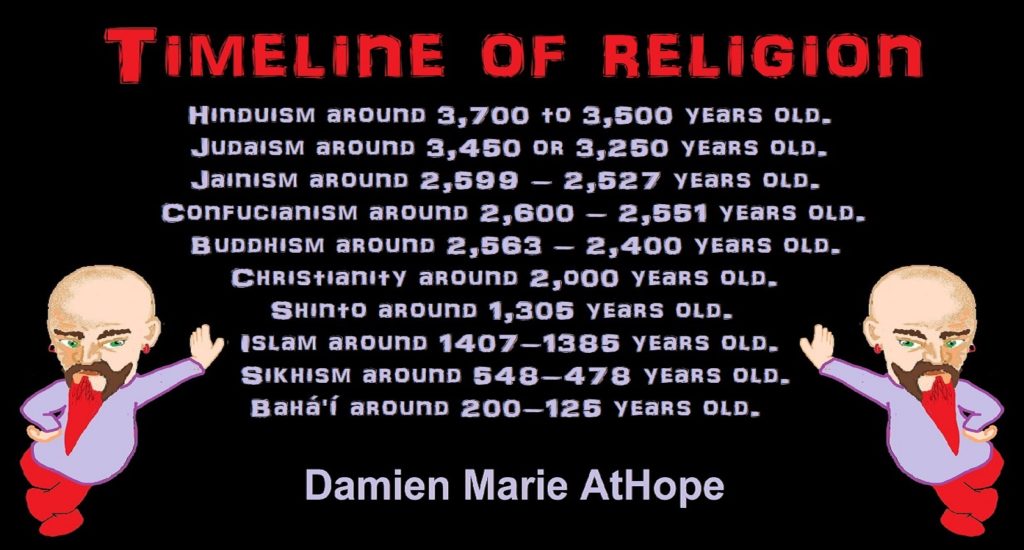
Hinduism around 3,700 to 3,500 years old. ref
Judaism around 3,450 or 3,250 years old. (The first writing in the bible was “Paleo-Hebrew” dated to around 3,000 years ago Khirbet Qeiyafa is the site of an ancient fortress city overlooking the Elah Valley. And many believe the religious Jewish texts were completed around 2,500) ref, ref
Judaism is around 3,450 or 3,250 years old. (“Paleo-Hebrew” 3,000 years ago and Torah 2,500 years ago)
“Judaism is an Abrahamic, its roots as an organized religion in the Middle East during the Bronze Age. Some scholars argue that modern Judaism evolved from Yahwism, the religion of ancient Israel and Judah, by the late 6th century BCE, and is thus considered to be one of the oldest monotheistic religions.” ref
“Yahwism is the name given by modern scholars to the religion of ancient Israel, essentially polytheistic, with a plethora of gods and goddesses. Heading the pantheon was Yahweh, the national god of the Israelite kingdoms of Israel and Judah, with his consort, the goddess Asherah; below them were second-tier gods and goddesses such as Baal, Shamash, Yarikh, Mot, and Astarte, all of whom had their own priests and prophets and numbered royalty among their devotees, and a third and fourth tier of minor divine beings, including the mal’ak, the messengers of the higher gods, who in later times became the angels of Judaism, Christianity and Islam. Yahweh, however, was not the ‘original’ god of Israel “Isra-El”; it is El, the head of the Canaanite pantheon, whose name forms the basis of the name “Israel”, and none of the Old Testament patriarchs, the tribes of Israel, the Judges, or the earliest monarchs, have a Yahwistic theophoric name (i.e., one incorporating the name of Yahweh).” ref
“El is a Northwest Semitic word meaning “god” or “deity“, or referring (as a proper name) to any one of multiple major ancient Near Eastern deities. A rarer form, ‘ila, represents the predicate form in Old Akkadian and in Amorite. The word is derived from the Proto-Semitic *ʔil-, meaning “god”. Specific deities known as ‘El or ‘Il include the supreme god of the ancient Canaanite religion and the supreme god of East Semitic speakers in Mesopotamia’s Early Dynastic Period. ʼĒl is listed at the head of many pantheons. In some Canaanite and Ugaritic sources, ʼĒl played a role as father of the gods, of creation, or both. For example, in the Ugaritic texts, ʾil mlk is understood to mean “ʼĒl the King” but ʾil hd as “the god Hadad“. The Semitic root ʾlh (Arabic ʾilāh, Aramaic ʾAlāh, ʾElāh, Hebrew ʾelōah) may be ʾl with a parasitic h, and ʾl may be an abbreviated form of ʾlh. In Ugaritic the plural form meaning “gods” is ʾilhm, equivalent to Hebrew ʾelōhîm “powers”. In the Hebrew texts this word is interpreted as being semantically singular for “god” by biblical commentators. However the documentary hypothesis for the Old Testament (corresponds to the Jewish Torah) developed originally in the 1870s, identifies these that different authors – the Jahwist, Elohist, Deuteronomist, and the Priestly source – were responsible for editing stories from a polytheistic religion into those of a monotheistic religion. Inconsistencies that arise between monotheism and polytheism in the texts are reflective of this hypothesis.” ref
Jainism around 2,599 – 2,527 years old. ref
Confucianism around 2,600 – 2,551 years old. ref
Buddhism around 2,563/2,480 – 2,483/2,400 years old. ref
Christianity around 2,o00 years old. ref
Shinto around 1,305 years old. ref
Islam around 1407–1385 years old. ref

Knowledge to Ponder:
Stars/Astrology:
- Possibly, around 30,000 years ago (in simpler form) to 6,000 years ago, Stars/Astrology are connected to Ancestors, Spirit Animals, and Deities.
- The star also seems to be a possible proto-star for Star of Ishtar, Star of Inanna, or Star of Venus.
- Around 7,000 to 6,000 years ago, Star Constellations/Astrology have connections to the “Kurgan phenomenon” of below-ground “mound” stone/wood burial structures and “Dolmen phenomenon” of above-ground stone burial structures.
- Around 6,500–5,800 years ago, The Northern Levant migrations into Jordon and Israel in the Southern Levant brought new cultural and religious transfer from Turkey and Iran.
- “The Ghassulian Star,” a mysterious 6,000-year-old mural from Jordan may have connections to the European paganstic kurgan/dolmens phenomenon.
“Astrology is a range of divinatory practices, recognized as pseudoscientific since the 18th century, that claim to discern information about human affairs and terrestrial events by studying the apparent positions of celestial objects. Different cultures have employed forms of astrology since at least the 2nd millennium BCE, these practices having originated in calendrical systems used to predict seasonal shifts and to interpret celestial cycles as signs of divine communications. Most, if not all, cultures have attached importance to what they observed in the sky, and some—such as the Hindus, Chinese, and the Maya—developed elaborate systems for predicting terrestrial events from celestial observations. Western astrology, one of the oldest astrological systems still in use, can trace its roots to 19th–17th century BCE Mesopotamia, from where it spread to Ancient Greece, Rome, the Islamicate world and eventually Central and Western Europe. Contemporary Western astrology is often associated with systems of horoscopes that purport to explain aspects of a person’s personality and predict significant events in their lives based on the positions of celestial objects; the majority of professional astrologers rely on such systems.” ref
Around 5,500 years ago, Science evolves, The first evidence of science was 5,500 years ago and was demonstrated by a body of empirical, theoretical, and practical knowledge about the natural world. ref
Around 5,000 years ago, Origin of Logics is a Naturalistic Observation (principles of valid reasoning, inference, & demonstration) ref
Around 4,150 to 4,000 years ago: The earliest surviving versions of the Sumerian Epic of Gilgamesh, which was originally titled “He who Saw the Deep” (Sha naqba īmuru) or “Surpassing All Other Kings” (Shūtur eli sharrī) were written. ref
Hinduism:
- 3,700 years ago or so, the oldest of the Hindu Vedas (scriptures), the Rig Veda was composed.
- 3,500 years ago or so, the Vedic Age began in India after the collapse of the Indus Valley Civilization.
Judaism:
- around 3,000 years ago, the first writing in the bible was “Paleo-Hebrew”
- around 2,500 years ago, many believe the religious Jewish texts were completed
Myths: The bible inspired religion is not just one religion or one myth but a grouping of several religions and myths
- Around 3,450 or 3,250 years ago, according to legend, is the traditionally accepted period in which the Israelite lawgiver, Moses, provided the Ten Commandments.
- Around 2,500 to 2,400 years ago, a collection of ancient religious writings by the Israelites based primarily upon the Hebrew Bible, Tanakh, or Old Testament is the first part of Christianity’s bible.
- Around 2,400 years ago, the most accepted hypothesis is that the canon was formed in stages, first the Pentateuch (Torah).
- Around 2,140 to 2,116 years ago, the Prophets was written during the Hasmonean dynasty, and finally the remaining books.
- Christians traditionally divide the Old Testament into four sections:
- The first five books or Pentateuch (Torah).
- The proposed history books telling the history of the Israelites from their conquest of Canaan to their defeat and exile in Babylon.
- The poetic and proposed “Wisdom books” dealing, in various forms, with questions of good and evil in the world.
- The books of the biblical prophets, warning of the consequences of turning away from God:
- Henotheism:
- Exodus 20:23 “You shall not make other gods besides Me (not saying there are no other gods just not to worship them); gods of silver or gods of gold, you shall not make for yourselves.”
- Polytheism:
- Judges 10:6 “Then the sons of Israel again did evil in the sight of the LORD, served the Baals and the Ashtaroth, the gods of Aram, the gods of Sidon, the gods of Moab, the gods of the sons of Ammon, and the gods of the Philistines; thus they forsook the LORD and did not serve Him.”
- 1 Corinthians 8:5 “For even if there are so-called gods whether in heaven or on earth, as indeed there are many gods and many lords.”
- Monotheism:
- Isaiah 43:10 “You are my witnesses,” declares the LORD, “and my servant whom I have chosen, so that you may know and believe me and understand that I am he. Before me no god was formed, nor will there be one after me.
Around 2,570 to 2,270 Years Ago, there is a confirmation of atheistic doubting as well as atheistic thinking, mainly by Greek philosophers. However, doubting gods is likely as old as the invention of gods and should destroy the thinking that belief in god(s) is the “default belief”. The Greek word is apistos (a “not” and pistos “faithful,”), thus not faithful or faithless because one is unpersuaded and unconvinced by a god(s) claim. Short Definition: unbelieving, unbeliever, or unbelief.

Expressions of Atheistic Thinking:
- Around 2,600 years ago, Ajita Kesakambali, ancient Indian philosopher, who is the first known proponent of Indian materialism. ref
- Around 2,535 to 2,475 years ago, Heraclitus, Greek pre-Socratic philosopher, a native of the Greek city Ephesus, Ionia, on the coast of Anatolia, also known as Asia Minor or modern Turkey. ref
- Around 2,500 to 2,400 years ago, according to The Story of Civilization book series certain African pygmy tribes have no identifiable gods, spirits, or religious beliefs or rituals, and even what burials accrue are without ceremony. ref
- Around 2,490 to 2,430 years ago, Empedocles, Greek pre-Socratic philosopher and a citizen of Agrigentum, a Greek city in Sicily. ref
- Around 2,460 to 2,370 years ago, Democritus, Greek pre-Socratic philosopher considered to be the “father of modern science” possibly had some disbelief amounting to atheism. ref
- Around 2,399 years ago or so, Socrates, a famous Greek philosopher was tried for sinfulness by teaching doubt of state gods. ref
- Around 2,341 to 2,270 years ago, Epicurus, a Greek philosopher known for composing atheistic critics and famously stated, “Is God willing to prevent evil, but not able? Then he is not omnipotent. Is he able, but not willing? Then he is malevolent. Is he both able and willing? Then whence cometh evil? Is he neither able nor willing? Then why call him god?” ref
This last expression by Epicurus, seems to be an expression of Axiological Atheism. To understand and utilize value or actually possess “Value Conscious/Consciousness” to both give a strong moral “axiological” argument (the problem of evil) as well as use it to fortify humanism and positive ethical persuasion of human helping and care responsibilities. Because value-blindness gives rise to sociopathic/psychopathic evil.



While hallucinogens are associated with shamanism, it is alcohol that is associated with paganism.
The Atheist-Humanist-Leftist Revolutionaries Shows in the prehistory series:
Show two: Pre-animism 300,000 years old and animism 100,000 years old: related to “Anarchism and Socialism”
Show tree: Totemism 50,000 years old: related to “Anarchism and Socialism”
Show four: Shamanism 30,000 years old: related to “Anarchism and Socialism”
Show five: Paganism 12,000 years old: related to “Anarchism and Socialism”
Show six: Emergence of hierarchy, sexism, slavery, and the new male god dominance: Paganism 7,000-5,000 years old: related to “Anarchism and Socialism” (Capitalism) (World War 0) Elite and their slaves!
Prehistory: related to “Anarchism and Socialism” the division of labor, power, rights, and recourses: VIDEO
Pre-animism 300,000 years old and animism 100,000 years old: related to “Anarchism and Socialism”: VIDEO
Totemism 50,000 years old: related to “Anarchism and Socialism”: VIDEO
Shamanism 30,000 years old: related to “Anarchism and Socialism”: VIDEO
Paganism 12,000 years old: related to “Anarchism and Socialism” (Pre-Capitalism): VIDEO
Paganism 7,000-5,000 years old: related to “Anarchism and Socialism” (Capitalism) (World War 0) Elite and their slaves: VIEDO
Paganism 5,000 years old: progressed organized religion and the state: related to “Anarchism and Socialism” (Kings and the Rise of the State): VIEDO
Paganism 4,000 years old: related to “Anarchism and Socialism” (First Moralistic gods, then the Origin time of Monotheism): VIEDO
I do not hate simply because I challenge and expose myths or lies any more than others being thought of as loving simply because of the protection and hiding from challenge their favored myths or lies.
The truth is best championed in the sunlight of challenge.
An archaeologist once said to me “Damien religion and culture are very different”
My response, So are you saying that was always that way, such as would you say Native Americans’ cultures are separate from their religions? And do you think it always was the way you believe?
I had said that religion was a cultural product. That is still how I see it and there are other archaeologists that think close to me as well. Gods too are the myths of cultures that did not understand science or the world around them, seeing magic/supernatural everywhere.
I personally think there is a goddess and not enough evidence to support a male god at Çatalhöyük but if there was both a male and female god and goddess then I know the kind of gods they were like Proto-Indo-European mythology.
This series idea was addressed in, Anarchist Teaching as Free Public Education or Free Education in the Public: VIDEO
Our 12 video series: Organized Oppression: Mesopotamian State Force and the Politics of power (9,000-4,000 years ago), is adapted from: The Complete and Concise History of the Sumerians and Early Bronze Age Mesopotamia (7000-2000 BC): https://www.youtube.com/watch?v=szFjxmY7jQA by “History with Cy“
Show #1: Mesopotamian State Force and the Politics of Power (Samarra, Halaf, Ubaid)
Show #2: Mesopotamian State Force and the Politics of Power
Show #3: Mesopotamian State Force and the Politics of Power (Uruk and the First Cities)
Show #4: Mesopotamian State Force and the Politics of Power (First Kings)
Show #5: Mesopotamian State Force and the Politics of Power (Early Dynastic Period)
Show #6: Mesopotamian State Force and the Politics of Power
Show #7: Mesopotamian State Force and the Politics of Power (Sargon and Akkadian Rule)
Show #9: Mesopotamian State Force and the Politics of Power (Gudea of Lagash and Utu-hegal)
Show #12: Mesopotamian State Force and the Politics of Power (Aftermath and Legacy of Sumer)

The “Atheist-Humanist-Leftist Revolutionaries”
Cory Johnston ☭ Ⓐ Atheist Leftist @Skepticallefty & I (Damien Marie AtHope) @AthopeMarie (my YouTube & related blog) are working jointly in atheist, antitheist, antireligionist, antifascist, anarchist, socialist, and humanist endeavors in our videos together, generally, every other Saturday.
Why Does Power Bring Responsibility?
Think, how often is it the powerless that start wars, oppress others, or commit genocide? So, I guess the question is to us all, to ask, how can power not carry responsibility in a humanity concept? I know I see the deep ethical responsibility that if there is power their must be a humanistic responsibility of ethical and empathic stewardship of that power. Will I be brave enough to be kind? Will I possess enough courage to be compassionate? Will my valor reach its height of empathy? I as everyone, earns our justified respect by our actions, that are good, ethical, just, protecting, and kind. Do I have enough self-respect to put my love for humanity’s flushing, over being brought down by some of its bad actors? May we all be the ones doing good actions in the world, to help human flourishing.
I create the world I want to live in, striving for flourishing. Which is not a place but a positive potential involvement and promotion; a life of humanist goal precision. To master oneself, also means mastering positive prosocial behaviors needed for human flourishing. I may have lost a god myth as an atheist, but I am happy to tell you, my friend, it is exactly because of that, leaving the mental terrorizer, god belief, that I truly regained my connected ethical as well as kind humanity.
Cory and I will talk about prehistory and theism, addressing the relevance to atheism, anarchism, and socialism.
At the same time as the rise of the male god, 7,000 years ago, there was also the very time there was the rise of violence, war, and clans to kingdoms, then empires, then states. It is all connected back to 7,000 years ago, and it moved across the world.
Cory Johnston: https://damienmarieathope.com/2021/04/cory-johnston-mind-of-a-skeptical-leftist/?v=32aec8db952d
The Mind of a Skeptical Leftist (YouTube)
Cory Johnston: Mind of a Skeptical Leftist @Skepticallefty
The Mind of a Skeptical Leftist By Cory Johnston: “Promoting critical thinking, social justice, and left-wing politics by covering current events and talking to a variety of people. Cory Johnston has been thoughtfully talking to people and attempting to promote critical thinking, social justice, and left-wing politics.” http://anchor.fm/skepticalleft
Cory needs our support. We rise by helping each other.
Cory Johnston ☭ Ⓐ @Skepticallefty Evidence-based atheist leftist (he/him) Producer, host, and co-host of 4 podcasts @skeptarchy @skpoliticspod and @AthopeMarie
Damien Marie AtHope (“At Hope”) Axiological Atheist, Anti-theist, Anti-religionist, Secular Humanist. Rationalist, Writer, Artist, Poet, Philosopher, Advocate, Activist, Psychology, and Armchair Archaeology/Anthropology/Historian.
Damien is interested in: Freedom, Liberty, Justice, Equality, Ethics, Humanism, Science, Atheism, Antiteism, Antireligionism, Ignosticism, Left-Libertarianism, Anarchism, Socialism, Mutualism, Axiology, Metaphysics, LGBTQI, Philosophy, Advocacy, Activism, Mental Health, Psychology, Archaeology, Social Work, Sexual Rights, Marriage Rights, Woman’s Rights, Gender Rights, Child Rights, Secular Rights, Race Equality, Ageism/Disability Equality, Etc. And a far-leftist, “Anarcho-Humanist.”
I am not a good fit in the atheist movement that is mostly pro-capitalist, I am anti-capitalist. Mostly pro-skeptic, I am a rationalist not valuing skepticism. Mostly pro-agnostic, I am anti-agnostic. Mostly limited to anti-Abrahamic religions, I am an anti-religionist.
To me, the “male god” seems to have either emerged or become prominent around 7,000 years ago, whereas the now favored monotheism “male god” is more like 4,000 years ago or so. To me, the “female goddess” seems to have either emerged or become prominent around 11,000-10,000 years ago or so, losing the majority of its once prominence around 2,000 years ago due largely to the now favored monotheism “male god” that grow in prominence after 4,000 years ago or so.
My Thought on the Evolution of Gods?
Animal protector deities from old totems/spirit animal beliefs come first to me, 13,000/12,000 years ago, then women as deities 11,000/10,000 years ago, then male gods around 7,000/8,000 years ago. Moralistic gods around 5,000/4,000 years ago, and monotheistic gods around 4,000/3,000 years ago.


Damien Marie AtHope (Said as “At” “Hope”)/(Autodidact Polymath but not good at math):
Axiological Atheist, Anti-theist, Anti-religionist, Secular Humanist, Rationalist, Writer, Artist, Jeweler, Poet, “autodidact” Philosopher, schooled in Psychology, and “autodidact” Armchair Archaeology/Anthropology/Pre-Historian (Knowledgeable in the range of: 1 million to 5,000/4,000 years ago). I am an anarchist socialist politically. Reasons for or Types of Atheism
My Website, My Blog, & Short-writing or Quotes, My YouTube, Twitter: @AthopeMarie, and My Email: damien.marie.athope@gmail.com

